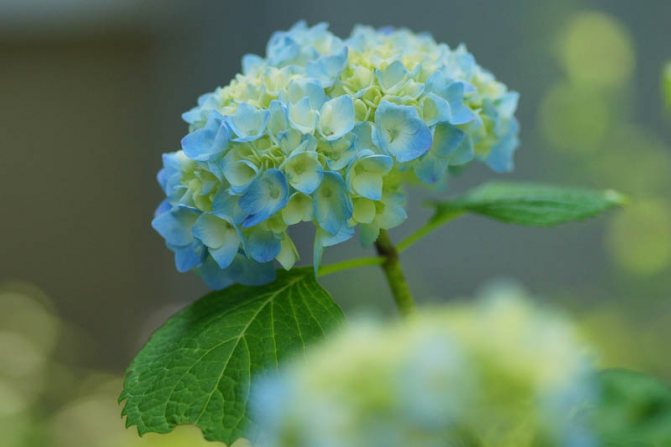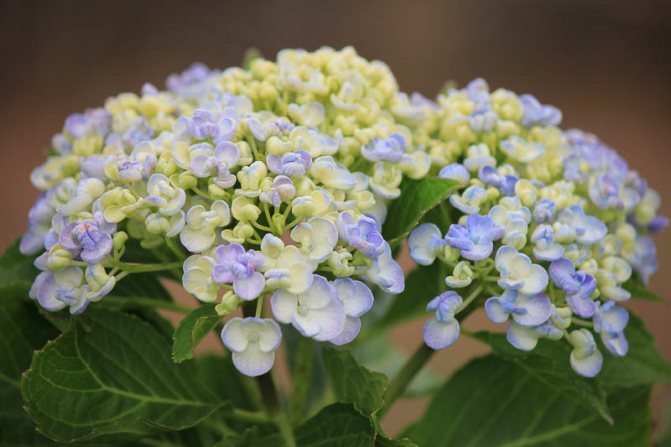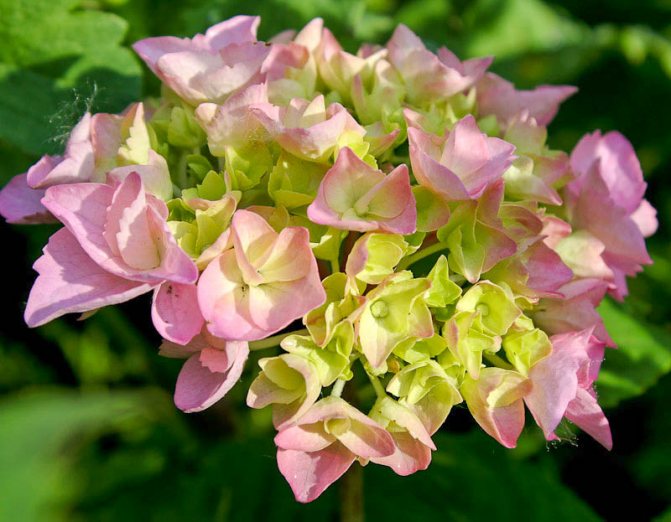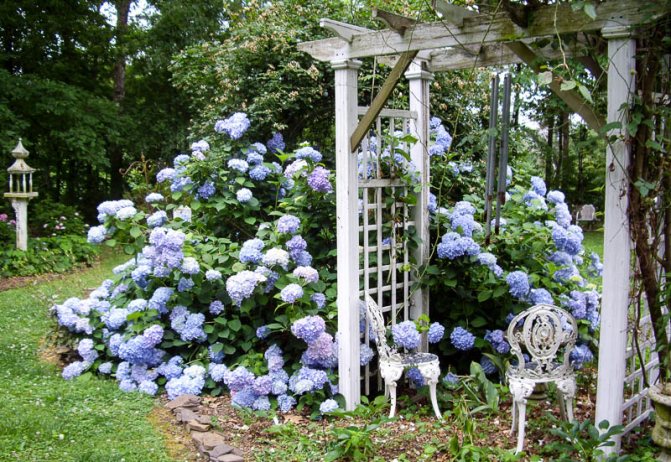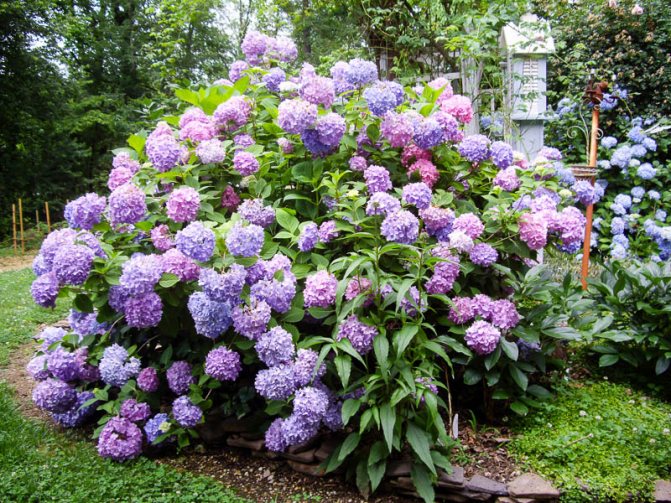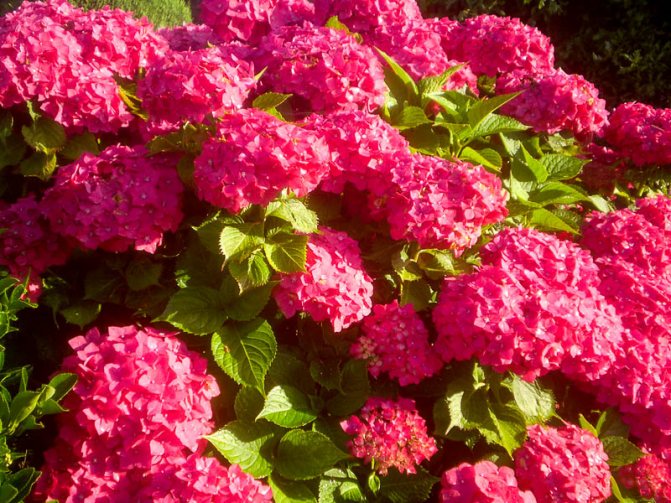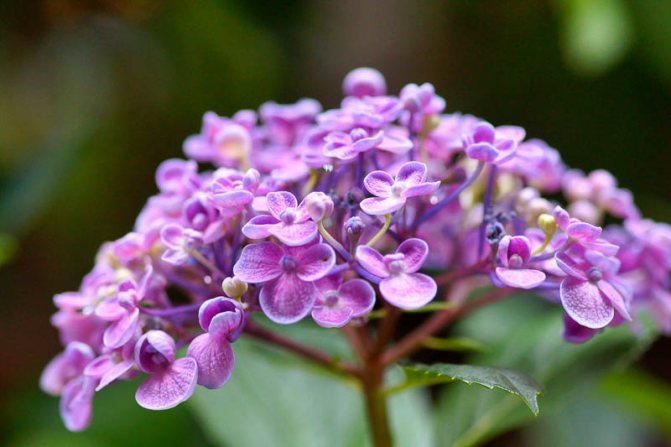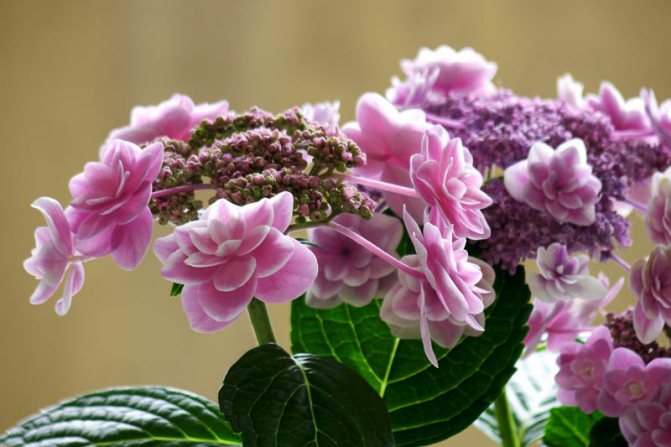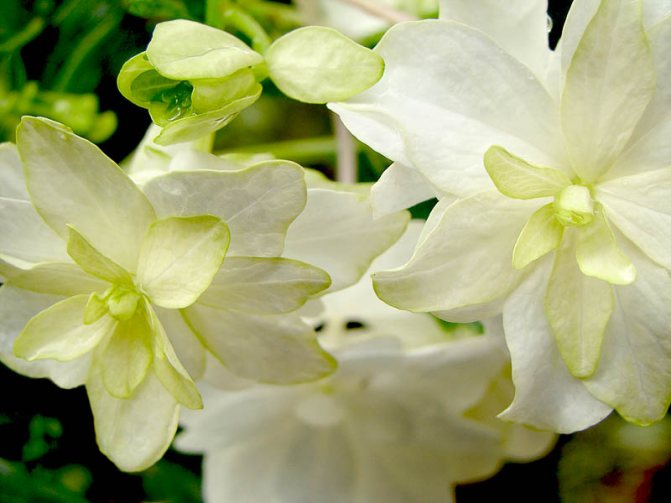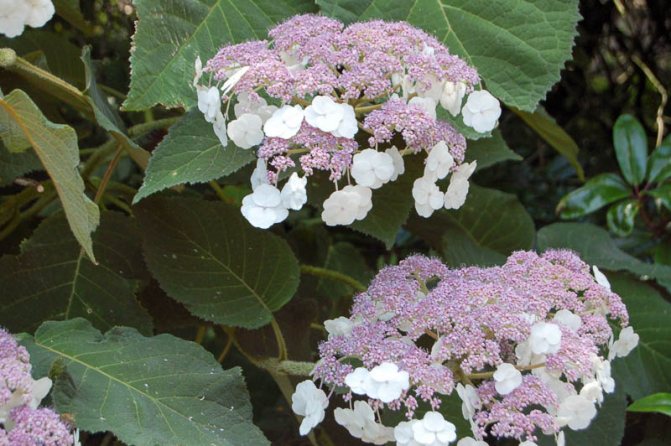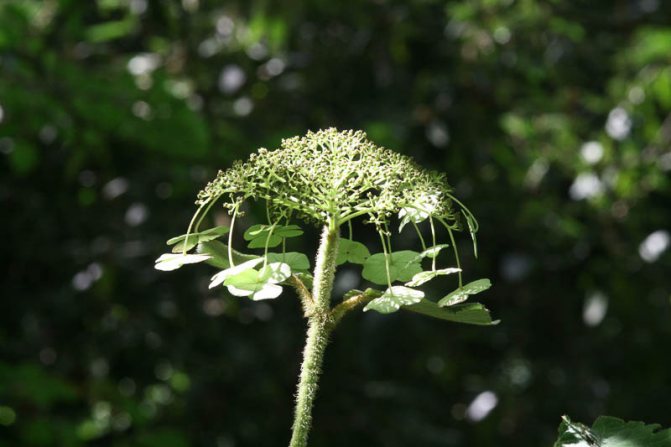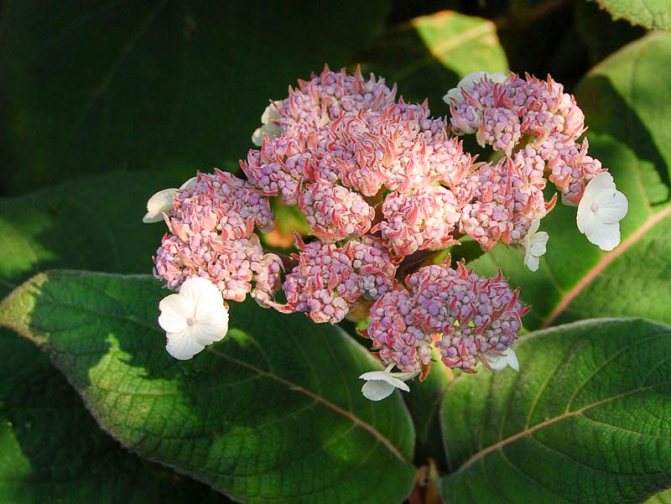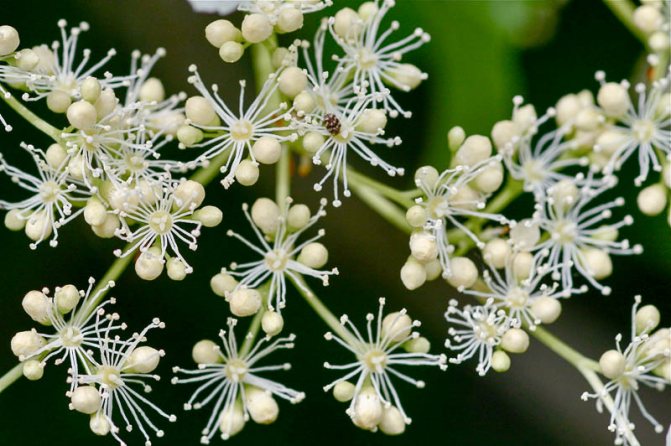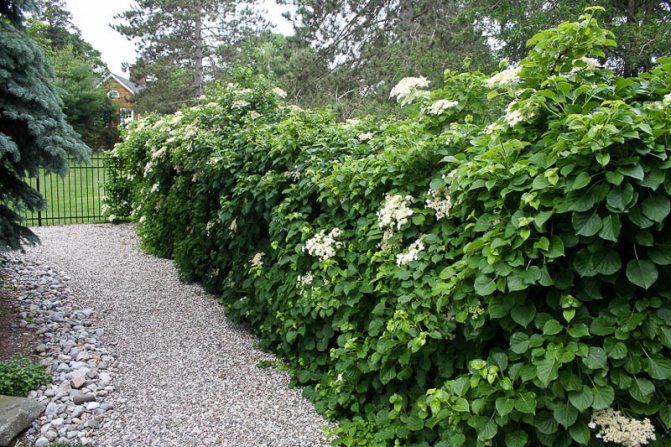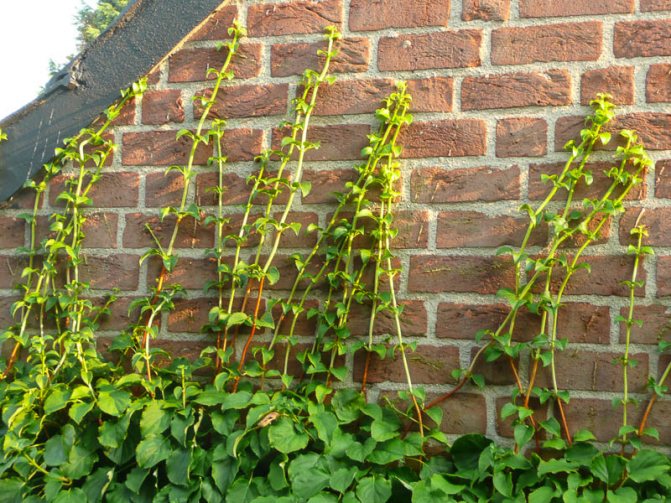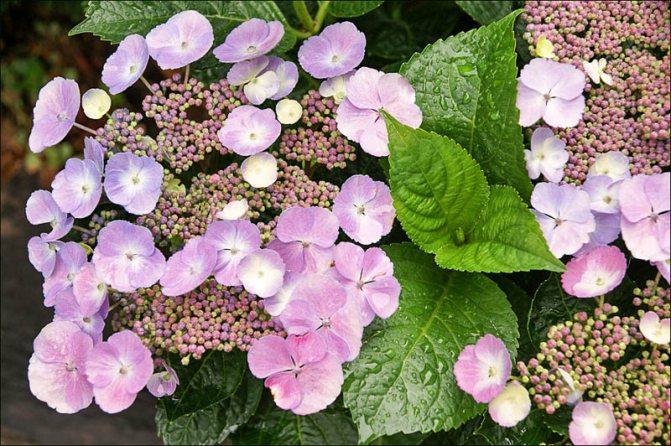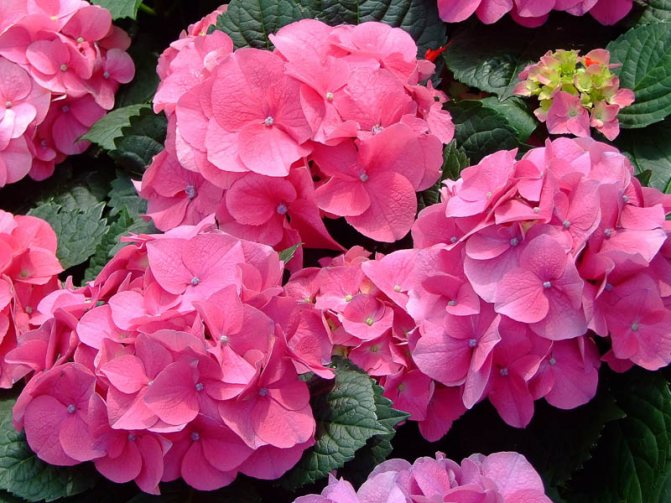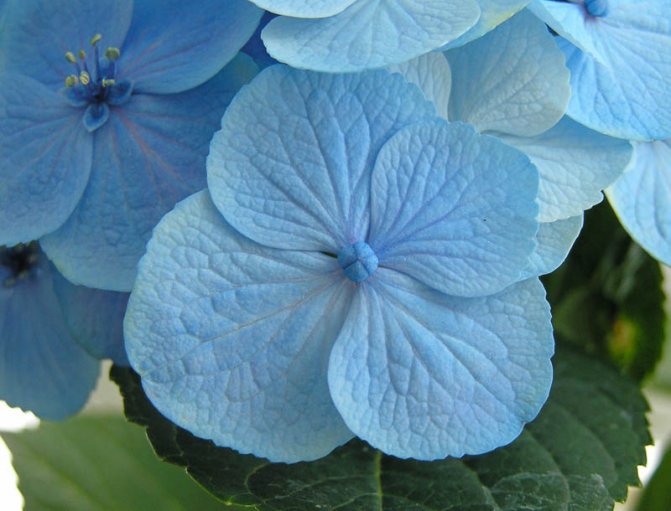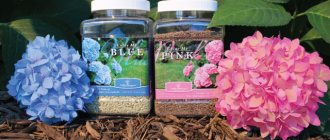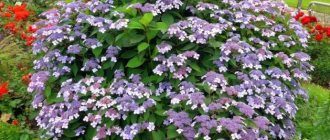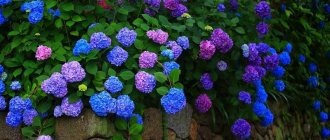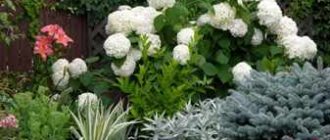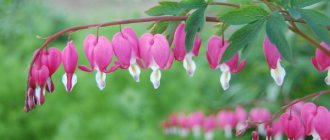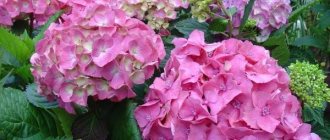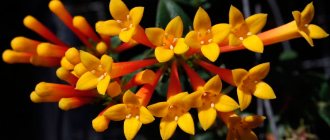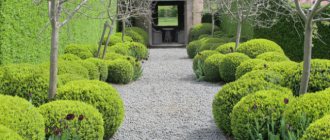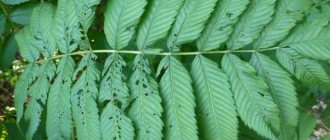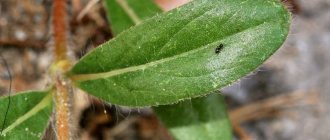- Hydrangea ground cover, or mixed pubescent Winter hardiness
- Groundcover hydrangea varieties
- Winter hardiness
- Growing conditions
- Winter hardiness
Flower appearance
In nature, hydrangea grows like a shrub and reaches a height of about 3 meters. Each species differs from the other in its characteristics; you can find evergreen representatives, or deciduous ones. In areas with moderate climatic conditions, flower growers give preference to plants shedding foliage.
The leaves of the flower are arranged oppositely, have the shape of ovals, ending with a sharp pommel, edges with denticles and clearly visible veins. Flowering begins in spring and ends with the onset of frost. Inflorescences in the form of huge balls, corymbose or paniculate.
Most varieties have snow-white flowers, however, large-leaved hydrangeas can have cream, blue, purple and pink colors.
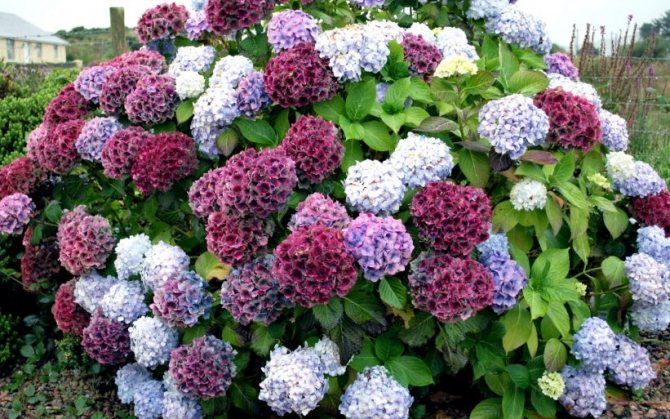
Growing hydrangeas in the garden
Notes for the plant lover. These unusual color variations are associated with soil hydrogen values. All this applies to the large-leaved species.
- neutral soil will give a beige or cream color;
- alkaline - purple or pink;
- acidic due to the aluminum content absorbed by the plant - blue.
Hydrangea fruits are capsules consisting of two or five chambers filled with small seeds.
Hydrangea ground cover, or various pubescent
Hydrangea ground cover, or mixed pubescent (Hydrangea heteromalla), is a shrub with a broadly rounded crown up to 2 m in diameter with reddish-brown shoots. The plant is native to the forests of Northern China. Blooms in July-August for 2-3 weeks. White flowers are collected in large inflorescences up to 16 cm in diameter. Over time, they acquire a purple hue and stay on the plant for a long time.
Winter hardiness
One of the most winter-hardy and drought-resistant types of hydrangeas presented in our selection. Requires shelter only at a young age.
Groundcover hydrangea varieties
The popular Bretschneideri variety differs from the species in its larger inflorescences. More recently, it was considered a great rarity, but now it has begun to actively appear on sale. The flowers when dissolved have a greenish tint, and at the end of flowering they turn purple. Blooms profusely.
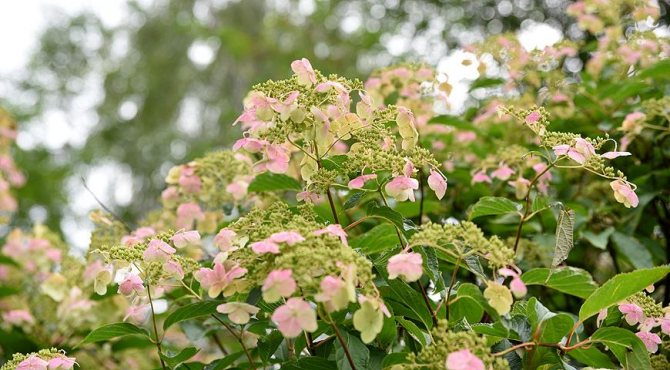

pictured hydrangea Bretschneideri
Growing hydrangeas in the garden. What are the tricks?
- The plant belongs to a moisture-loving species, it will be important not to forget about watering.
- Hydrangeas love the sun, but bright, direct light will burn out very sensitive petals. The best place for planting is a small partial shade, which will protect the flower on a hot afternoon.
- One of the most important aspects of maintenance, apart from watering, is pruning done on time.
- An excess of organic fertilizer leads to excellent development of hydrangea green leaves, but flowers may not appear.
- There are frost-resistant varieties, but even they will need to make a warm shelter when winter comes. All known cases of slight freezing end safely, the plant recovers during the growing season.
- Pests and diseases practically do not affect the hydrangea.
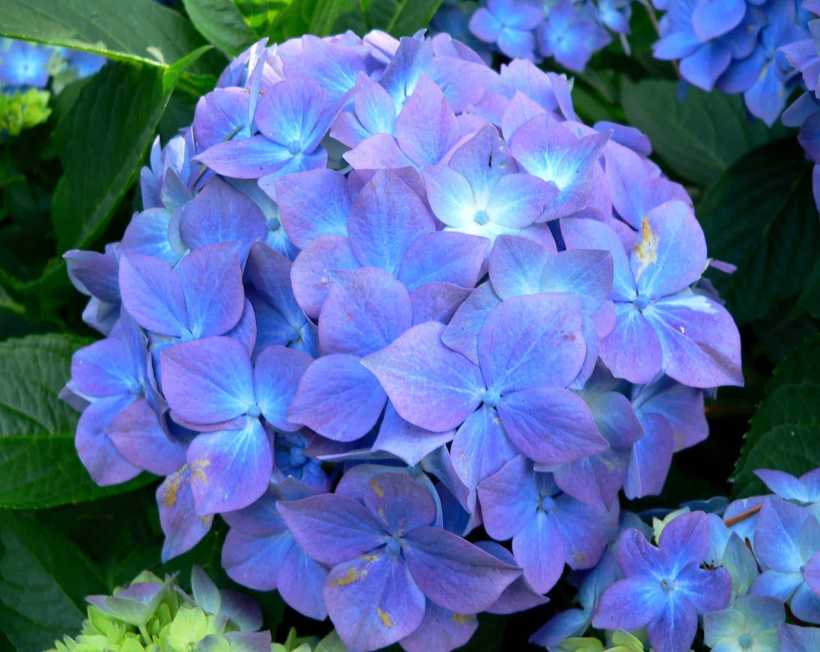

How to plant hydrangea in the garden
WHAT YOU NEED TO REMEMBER WHEN CARING FOR HORTENSES
In the central and northern regions of Russia, only three types of hydrangeas are grown: tree, paniculate and large-leaved. Some gardeners successfully cultivate in their garden even less winter-hardy oak-leaved hydrangea.
These hydrangeas differ from each other in appearance, flower color, and frost resistance. Their formation and preparation for winter is carried out in different ways.
Otherwise, caring for them in the summer-autumn period is almost the same.
It should be remembered that the root system of all hydrangeas is located in the upper layer of the soil, therefore, when hilling and loosening, one should be very careful not to damage its roots, which are close to the surface of the earth.
The end of July and August are sometimes very hot, so at noon the plants should be shaded, otherwise they will lose their decorative effect. We have already written that the hydrangea should initially be planted in a partially shaded place.


How to plant a flower
The seed method of growing is somewhat laborious and takes time. Seeds are sown with the onset of autumn, having prepared for this loose soil, which includes:
- sheet land - 4 parts;
- peat - 2 parts;
- river sand - 1 part.
After sowing, it is necessary to sprinkle the seeds a little with a mixture of the same soil, and moisten from a spray bottle. The container must be covered with foil or glass to create a greenhouse effect. The ventilation of the crops is systematically arranged and at the same time the soil is moistened, the earth should be a little damp all the time. The ideal temperature for germination is +14 - +20 degrees.
After the first shoots appear (30 days or a little more), the film is removed. The first pick is carried out as soon as the cotyledon leaves begin to develop, the second with the onset of May. At the same time, a separate container is prepared for each seedling, where they need to be transplanted.
There comes a period for hardening the plants, during the daytime the pots are put outside in a place sheltered from direct sun, rain and strong winds. With the onset of evening, the seedlings must be returned to the room.
The hydrangea is grown for two years before being planted in open ground.
Pruning
Formative
Treelike hydrangea blooms on shoots that have appeared this year. Over time, the bushes thicken quickly, resulting in a decrease in flowering quality.
Regular, strong pruning, which is carried out in early spring (March-April), keeps the bushes in good condition. As a result, strong and strong shoots appear, on which large inflorescences bloom in summer or at the very beginning of autumn.
Strong shoots are shortened by 3-5 buds, weak ones - by 2-3 buds, so that the upper buds "look" outward. Then the shrub will be more lush, and the middle of the crown will not be thickened.
After pruning, the plants must be fed with full fertilizer with nitrogen, phosphorus and potassium.
Sanitary
Broken, dry and poorly developed shoots are cut out of young plants immediately after planting. In the second year, in the spring, formative pruning of these bushes is carried out, last year's branches are significantly shortened.
Rejuvenating
To rejuvenate mature bushes, a very strong pruning is carried out. During it, all branches are cut at a level of half a meter from the surface of the earth. After such pruning, the plants bloom only after a year.
| Young, not yet flowering specimens up to 4 years old are not pruned. |
Landing in open ground
Planting can be done either in early spring or in autumn, it is important for areas with cold climatic conditions.
It is necessary to choose a place on the site with the presence of slight shading during hot hours. The soil can be neutral, or slightly acidic, but always loose with a high content of organic components.Excess alkali is neutralized with peat. Soil preparation can be done with the Strizh weeder.
The depth of the planting pit should be twice the lump of earth in which the seedling grows. Peat, organic and mineral dressing is preliminarily introduced into the pit, which are first mixed with the soil.
The seedling needs to straighten the root system, and only then plant. At the end of the work, it is necessary to water and mulch.
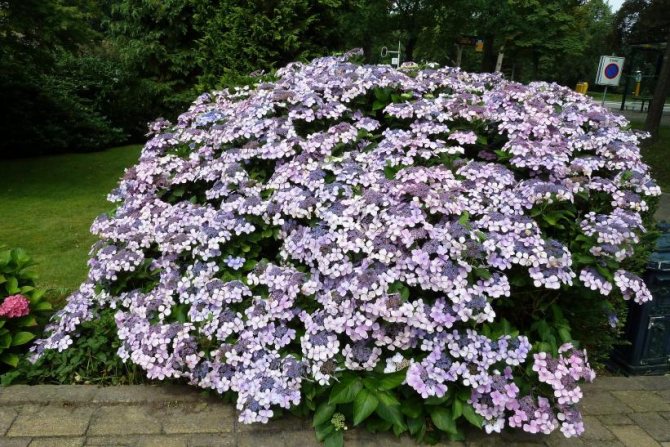

Hydrangea care and cultivation in the garden
FEATURES OF LANDING, TRANSPLANTING AND REPRODUCTION OF HORTENSIA
Hydrangea tolerates well both autumn and spring plantings, especially if the seedlings are with a closed root system. But in the fall, it is recommended to carry out this operation no later than September 15, so that the young bushes have time to take root well and prepare for winter.
It is also possible to transplant a hydrangea (entirely from one place to another) during these periods. But this should be done only as a last resort, because it is difficult for the plant to take root in a new place.
But when it comes to reproduction, be very careful here!
In spring and autumn, hydrangea can be propagated by layering, in summer by cuttings, and dividing the bush - only in the spring!
Many gardeners believe that all perennials should be planted only in late summer - August, early September. And they try to propagate hydrangeas in this way, digging bushes, disassembling them into pieces and planting them in new places.
Remember that 80 percent of them will not take root in you and will die. In the fall, hydrangeas can be propagated by division only in the southern regions.
Hydrangea reproduces well when dividing the bush in early spring - until the buds swell, as soon as the snow melts and the earth thaws. The best time for this is late April - early May.
We told you how to grow hydrangeas in the summer-autumn period. Now you can surely get some stunningly beautiful flowering shrubs. It remains only to choose the varieties.
Easy care for hydrangea in the garden
The most important point in plant care is proper watering. Growing hydrangeas in the garden is impossible without this simple act. One adult hydrangea will need from 30 to 50 liters of pre-settled water. Watering is done twice a week if it is hot.
A little trick. Mulched soil retains moisture much better, in which case the hydrangea will need to be watered less often.
Complex feeding at least 2 times a year helps to ensure a beautiful flowering:
- before flowering begins;
- after it ends.
With the onset of spring, urea is introduced 60 grams is bred into three buckets, this is exactly what an adult plant needs. At the end of flowering, the time comes for complex mineral fertilizers.
In the summer, gardeners recommend the systematic use of slurry for feeding.
It is important to consider! An overabundance of organic matter leads to the formation of very large inflorescences under whose weight the branches can break. Tying up the shoots will help avoid this trouble.
Pink hydrangea tree varieties
Hydrangea tree variety Invincibelle Spirit, Invincibelle, Pink Annabelle, NCHA1
Translated from English Invincible means "invincible", and spirit - "spirit". Due to the similarity with the widespread variety Annabelle, the originators somewhat distorted the first word in the name - Invincibelle.
The first cultivar in the world with inflorescences of pink sterile flowers was bred in the USA. This rather new variety has already won the hearts of thousands of flower growers around the world with its dark green-pink sterile flowers.
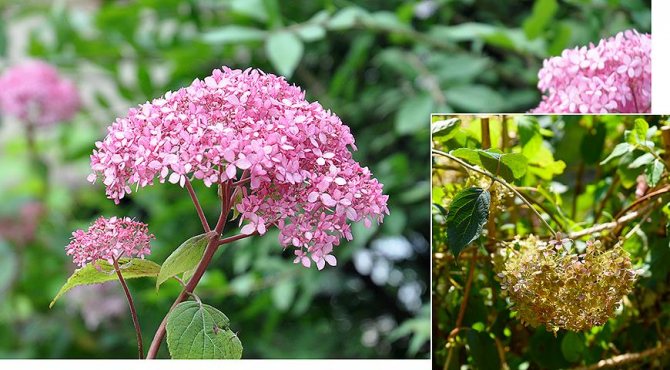

pictured hydrangea tree variety Invincibelle Spirit, Invincibelle, Pink Annabelle, NCHA1
Shrub up to 1.2 m high with strong shoots that do not sag in rainy or windy weather.
Winter hardiness is high. Does not tolerate prolonged stagnation of moisture and does not like watering over the leaves.
It is affected by phyllostictosis and gray rot.
Hydrangea tree variety Sweet Annabel, Sweet Annabel
The latest novelty in the Annabelle group
The bush is up to 1–1.2 m tall, with rather large flower heads. Inflorescences are initially deep pink in color, lighter in full dissolution, at the end they acquire a greenish tint.
Hydrangea tree variety Sweet Annabel, Sweet Annabel
Hydrangea tree variety Ruby Annabel, Ruby Annabel
The bush is 0.8-1.2 m high. The shoots are strong. The buds are dark red, the flowers are red-pink above, below - first with a burgundy tint, later pinkish.
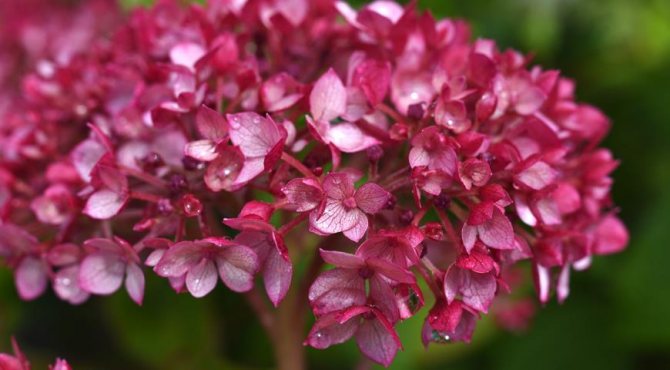

Hydrangea tree variety Ruby Annabel, Ruby Annabel
Hydrangea tree variety Pink Pincushion
The bush is 1–1.2 m high and 1.5 m in diameter. The ovoid leaves are green in summer and greenish-yellow in autumn. Flat-round inflorescences up to 10-15 cm in diameter consist mainly of fertile flowers, with rare interspersed with sterile ones. The buds are pink.
Blooms in June-August. Does not tolerate even short-term stagnation of moisture. In cold and damp summers, sterile flowers may be practically absent, and fertile flowers instead of pink may acquire a grayish tint.
Hydrangea tree variety Bella Anna
A new variety with large, globular pink inflorescences. Shrub up to 1.4 m high with erect shoots, which sometimes lodge during flowering. Light green ovoid leaves, turn bright yellow in autumn. Globular inflorescences are large, up to 25 cm in diameter. Flowers during dissolution and then remain bright pink throughout the entire flowering period. Blooms in June-July. Does not tolerate prolonged stagnation of moisture. At high air humidity, it is affected by phyllostictosis and gray rot.
Winter hardy.
Pruning features
Plants are pruned at three or four years of age. If the procedure is carried out too early, the cuttings cannot be used for propagation. The most appropriate moment is when the kidneys begin to swell a little and become alive.
Depending on the variety, pruning is done at different heights. In a tree hydrangea, these are three to four buds; in paniculata, shoots last year by 1/3. Large-leaved hydrangea needs a little rejuvenation with the removal of dead or broken branches.
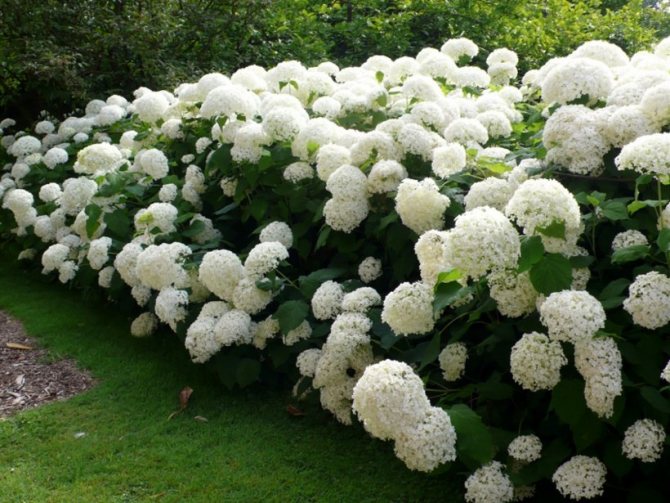

Hydrangea care and cultivation in the garden
Plant features
A rounded bush is formed by thin shoots, which are covered with a small amount of fluff. Ovate leaves about 20 cm long are painted in a bright green tint. Their undersides are light bluish-green. The leaves are attached to the branches with long and thin petioles. They are located on the shoots opposite each other (the so-called opposite arrangement).
Quite large inflorescences with a diameter of almost 15 cm, having the shape of a shield, are formed from whitish flowers about 2 cm wide. Lush flowering lasts from mid-July to October. The seeds ripen in October.
This type of hydrangea is different:
- good enough winter hardiness,
- the fact that it actively grows after winters with severe frosts,
- high percentage of rooting cuttings.
| Hydrangea arborescent grows best on soils with a slightly acidic reaction (pH at 5.0), but is more tolerant of lime in the ground than other varieties of hydrangeas. |
On the basis of this species, several varieties have been created that can be purchased in nurseries of our country:
- The well-known and very popular variety "Annabelle" attracts attention with large and heavy snow-white inflorescences up to 25 cm wide, which can lodge. This rather unpretentious and fast-growing plant reaches a height of 1.0 to 1.5 meters, and a width of almost 3 meters. Flowering lasts all summer (three months).
- Bushes "Grandiflora" ("Grandiflora") are liked for their spectacular appearance and long powerful flowering. Lush inflorescences change color several times during flowering. When blooming, the inflorescences are painted in a delicate greenish tint, then they become snow-white.By the end of flowering, the inflorescences take on a light whitish-cream shade. The height of the bush is about 2 meters, and the width can reach almost 3 meters.
- The variety "Invincibelle" or "Pink Annabelle" was created on the basis of "Annabelle". This is the first tree-like hydrangea to be colored pink. In addition to color, it is interesting in that if, after the first flowering, pruning of the bush is carried out, the plant will bloom again in 6 weeks. This variety received a bronze medal at the International Exhibition of Nursery Products "Plantarium 2011".
- Strong Annabelle or Incrediball is also sourced from Annabelle, but its white blossoms, which bloom on strong and sturdy branches, are resistant to wind and rain. Bloom lasts from June to September. This variety has received an award from an international competition.
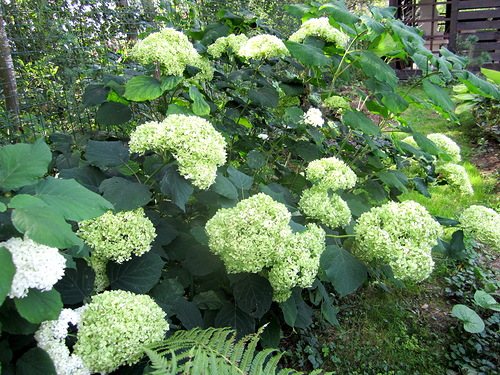

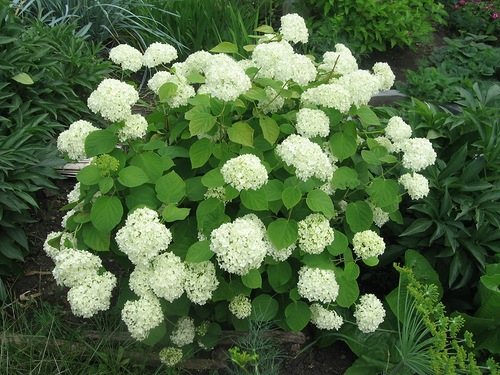

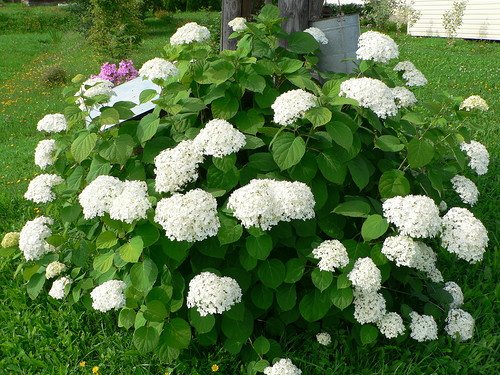

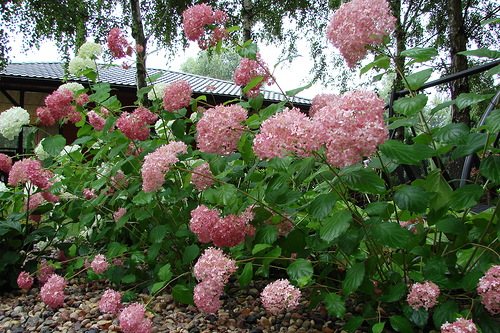

How to prepare hydrangea for winter
After flowering, you can start preparing for wintering. In plants in open ground, wilted inflorescences are removed, the base of the shrubs is earthed, mulching is performed to reliably protect the superficial root system. Frost-resistant varieties will need shelter - this is important for areas with severe cold.
The hydrangea is covered in October. Young shrubs are covered with dry soil to the ground. The older ones must be bent to the ground and covered with specialized materials that must be properly secured so that they cannot be carried away by a strong gust of wind.
Adult shrubs will have to be taken care of properly. They need to be tied and closed using lutrasil (covering material). A metal mesh surrounds the plant at a distance of 30 cm from it, the free space is filled with dry leaves. The height of the fence should be 15 cm higher than the hydrangea.
With the onset of spring, the foliage and the net are removed, and when the above-zero temperature is established, the covering material is removed.
Hydrangea Sargent
Hydrangea Sargent, or velvet (Hydrangea Sargentiana), is a plant native to China. The species is decorative with its leaves - they are very large (up to 20–25 cm long), abundantly pubescent. Petioles are long, pubescence is coarser, reddish, slightly prickly to the touch on annual shoots. The foliage does not change color and remains green until cold weather.
Unfortunately, in the middle lane, the plant is still quite rare. In warm regions, these are huge bushes with a height and diameter of up to 2.5 m.
pictured hydrangea Sargent, or velvet
Winter hardiness
The ground part of Sargent's hydrangea freezes annually in the middle zone, but the shoots growing over the season reach 1–1.5 m. In some years, inflorescences may appear on the shoots, especially adult specimens. Large, up to 15 cm in diameter, slightly lilac.
Frozen shoots of Sargent's hydrangea are best cut off in early June, when sap flow is restored.
A few words about pests
Hydrangea is a plant with very good immunity, but despite this, there are some diseases that can become a source of anxiety for the gardener:
- ring spot;
- septoria;
- downy mildew and powdery mildew;
- gray rot;
- white rot.
Of course, there are methods to combat each ailment, but the best measure is prevention. Before the growing season begins, it is recommended to carry out treatment with copper sulfate. This tool is an excellent disinfecting solution. Bordeaux liquid fights well against various types of fungus.
There are a huge number of varieties of hydrangea, before choosing the right one, it is recommended that you familiarize yourself with each of them in more detail, and learn all the intricacies of care so that the plant will delight its owner with beautiful flowering.
One interesting species deserves special attention.
The subtleties of the prevention of ailments
Competent hydrangea care is also prevention. It should be directed against:
- gray rot;
- powdery mildew;
- septoria;
- aphids;
- spider mites;
- bedbugs;
- scabbards.
If the bushes are damaged, first of all, you will need to drain them as soon as possible. You also need to remove the deformed areas and quickly go through the damaged parts with such fungicidal preparations as Jet, Topaz or Chistotsvet. Insects can be effectively removed by means of "Bison", "Iskra", "Tanrek".
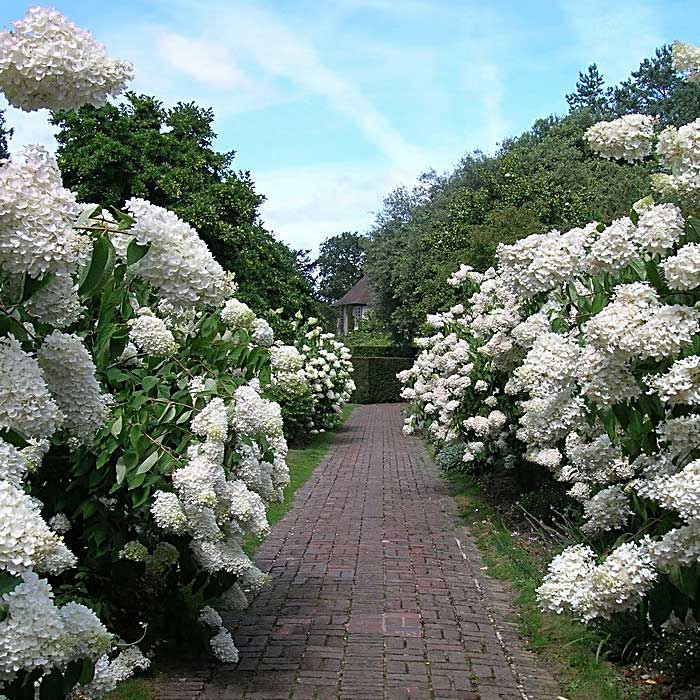

The best neighbors for hydrangeas that will not cause problems are conifers, trees and shrubs and perennials.
The ability to influence color is a rare gift of nature to man
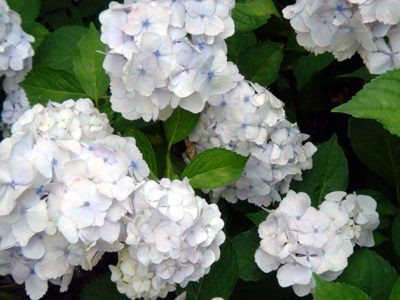

The beauty of the spherical inflorescences of the hydrangea is provided by sterile four-petal flowers bordering nondescript small fertile... From the latter, a seed capsule is formed, they are honey plants, but fruitless flowers, similar to moths, cause admiration.
At the very beginning of flowering, regardless of the variety, they are all light green in color. Only over time it becomes obvious what color the panicles will be.
A palette of blooming hydrangeas: from chaste white and pale beige through all shades of pink to delicate tones of lilac, blue and blue. It's hard to believe but the color of the inflorescences is determined by the acidity and the content of chemical elements in the soil:
- the presence of Al or Fe in the form of alum guarantees all shades of blue;
- on slightly alkaline soils, sterile flowers will have a pink (natural) color;
- The change in color is also facilitated by the introduction of peat.
ATTENTION: On sale there are harmless chemical compositions that can change the color of the inflorescences, with a greater or lesser intensity according to the amount of substance introduced.
This treatment is carried out during the beginning of the growing season. Regular use of additives gives unambiguity of the color of the panicles, irregular - the manifestation of bi-color.
Special hybrids of hydrangeas have been bred, which can change color and very easily "recolor" in the desired color - "NikkoBlue", "Blaumeise", etc. Snow-white varieties are the most difficult to change color; at best, their inflorescences can acquire a slightly pink tint. By influencing color samples, you can get complex shades of reds and blues - lilac, violet.
People have discovered this feature of influencing the color of hydrangea inflorescences by experience for a long time: they buried rusty objects on the bush or watered the plant with rusty water.
How to feed hydrangea properly?
The presented ornamental shrub needs feeding, which should be carried out with a certain regularity. Top dressing is especially important during the period of getting used to the new soil, that is, in the first season after planting. Such actions will help the root system quickly take root in a new place and give out shoots.
So, feed hydrangea follows in accordance with the type and variety. But on average, 4 mandatory dressings are distinguished for the entire spring-summer period of growth and flowering:
- For the first time, the plant is watered with special fertilizers during the period of leaf dissolution or immediately after planting, if it was carried out in the spring. Urea and potassium sulfate are used here. For 10 liters of pure water, there is a tablespoon of each component. One medium bush should "consume" 5 liters of the diluted solution.
- As soon as the hydrangea has pleased its owners with the first flower buds, a second feeding is carried out. Use any suitable flowering mixture. The purchased composition should be diluted in accordance with the instructions.
- The same top dressing can be used for the third procedure, when on each bush it will be possible to find 5 blossoming buds. This happens within 1-2 weeks after the second feeding.
- The fourth and final dressing is applied at the end of flowering.As soon as the petals began to fall off and the bush itself has already thinned out, it must be watered with a diluted solution, for the preparation of which a tablespoon of potassium sulfate is diluted in 10 liters of water. Watered in the same way as in the first case - 5 liters per bush.
Top dressing is very important for hydrangeas, so they should not be neglected. Quite often, gardeners complain about the lack of flowering, which is often explained by feeding not carried out in due time.
Planting hydrangeas in the ground, video:
Rational and regular watering
It is very difficult to overflow the plant, as the hydrangea loves water. For this event, it is better to use warm rainfall. You need to water the plant twice a day: in the morning and in the evening. If suddenly you did not water the plant enough, and the bush began to wither, then you do not need to immediately fill it with a large amount of water, this will negatively affect it. In this case, it is better to wait for the period when the sun sets and only then can the flower be watered abundantly.
Agrotechnical cultivation
Choosing a landing site
Hydrangea Incredible tree - description, planting and care
The landing site must be lit. But so that the hydrangea is not under the scorching rays of the sun. Otherwise, flowering will be reduced for several weeks. In the shade of the hydrangea, the petals and inflorescences become smaller.
The place should be closed from drafts. Since the shoots become heavy during flowering and lean to the ground, they will fall in different directions with gusts of wind. It will be ugly.
A distance of 2-3 meters is left from neighboring trees so that they do not take all the moisture.
Gardeners consider the north side near buildings to be a suitable place.
Soil preparation
Suitable soil types are slightly acidic (pH 5.0) and acidic loams. Treelike hydrangea is more tolerant of the presence of lime in the soil. Alkaline earth is generally not suitable.
To acidify the soil, add: peat, pine bark, sawdust, 6 months before planting.
Seedling preparation and propagation
Hydrangea breeding is carried out in several ways:
- Planting ready-made seedlings. Buy in early spring. An hour before disembarkation, the hydrangea is placed in warm water with potassium permanganate.
- Harvesting cuttings. Carried out in the second half of June or early July in the morning. First you need to cut annual, not hardened cuttings with 2 internodes. You need to get rid of half of the leaves. The lower cut is treated with a preparation that stimulates root growth, for example, Kornevin. A substrate is poured into the container, consisting of 1 part of sand and 2 peat. A stalk is placed at an angle of 45 degrees and to a depth of 2-3 cm. All seedlings should be 7-10 centimeters apart. The rooting process takes about a month. Cuttings can be planted by August.
- Reproduction by layering. The lateral annual shoot is placed in a trench dug to a depth of 10 cm. Layers are fastened with wire pins, sprinkled with earth. Around the appendix, the soil is loosened and watered. Next year, in the spring, you can separate the layers and plant them.
Disembarkation
Before budding in early spring, they begin planting in open ground.
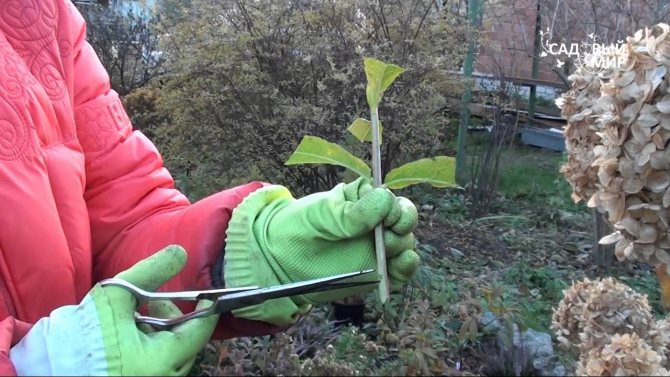

Hydrangea planting
Stages:
- Dig a hole 70 cm deep and 50 cm wide.
- The distance between several bushes is 1.5 meters, as the roots of the hydrangea grow horizontally.
- The well is filled with 1 hour - peat, 2 hours - humus, 1 hour - sand, 2 hours - black soil.
- The seedling is taken out of the container with manganese and the roots are shortened. Leaves and branches with damage are removed.
- Place the bush in the hole. The roots are spread in different directions.
- Cover with soil. The root collar should be covered with earth no more than 3 cm.
- Ramp down.
- Water abundantly so that the earth is saturated up to half a meter.
With proper planting, flowering is observed for 5 years.
Hydrangea care
It is necessary to water, fertilize, mulch, prune the plant.
Top dressing
Stages:
- After disembarkation, after 2 weeks, they are fed with a mixture of urea - 20 grams, potassium sulfate - 25 g, 40 grams of superphosphate.Fertilized annually in early spring;
- At the beginning of flowering, fertilize with organic and mineral substances. For example, Kemira-flower will do. You can make a mixture: superphosphate (50 grams) and potassium (40 g), added per square meter. Do not add a lot of nitrogen - the petals will take on a greenish tint. The plant's resistance to frost also decreases;
- At the end of summer, rotted manure is brought in, 15 kilograms per square meter.
Note! All feeding is stopped before the beginning of autumn, so that the branches become lignified by winter.
Watering
On very hot days, hydrangea should be watered every two days. The soil should be soaked up to half a meter deep and 1 meter in diameter. Once a month it is watered with a manganese solution for the strength of the branches.
Mulching
This procedure keeps the plant from overheating and helps to get rid of weeds.
In the spring, peat, a mixture of compost and sawdust are added to the mulch. This will increase the acidity of the soil.
Pruning
Pruning is done annually in spring and autumn. It is carried out for 3 years after disembarkation.
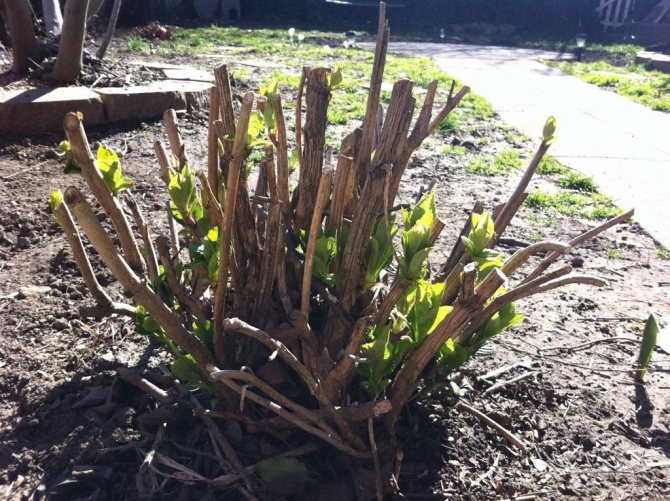

Hydrangea pruning
Stages:
- Prevention - removal of broken and dead shoots.
- Rejuvenation - for 5 year old plants. Remove old branches.
- Formation - last year's branches are reduced to 4 buds.
- Thinning - they remove the thickening bush and non-flowering branches.
Pruning improves the shape of the bush, flowering, and corrects the number of inflorescences.
After wilting, flowers are cut in autumn.
Warming
Stages:
- Remove foliage;
- Pour sawdust under the bush;
- Put boards around the bush and attach shoots to them;
- Cover with foil and sawdust.
In such conditions, hydrangea will have an attractive appearance for many years.
The soil
For hydrangeas, a loose, moisture-absorbing, air-permeable soil with a high humus content is needed. A special requirement is the acidity of the soil - hydrangeas prefer slightly acidic or even acidic soils, the pH should be close to 5.5. Therefore, fresh manure cannot be applied under them - it shifts the acidity of the soil to neutral and alkaline. And under such conditions, plants develop leaf chlorosis, caused by poor absorption of iron. It is better to use humus and peat as organic additives for hydrangeas. Heavy soil can be corrected by adding coarse river sand. If the soil is neutral, it is acidified with aluminum sulfate, ammonium sulfate or potassium chloride. The acidity level can be determined by changing the color of the hydrangeas. If the flowers turn pink, it means that the soil is not acidic enough and the plant may soon get sick.
How to prolong the joy of admiration?
The flowering bush pleases the eye for several months, the inflorescences cut for a bouquet stand in the water for 2 weeks. But the desire to extend the flowering time prompted the florists to preserve the blooming hydrangea in different ways for up to a year. This is drying:
- right on the bush, waiting for the state of the papery fragility of the petals;
- drying in a cool room in a suspended state with the heads down (preferably without touching other branches);
- drying in water, when a plant cut for a bouquet with a stem height of 40 cm is given the opportunity to live in a vase of water filled to the middle of the stem, without replenishing with life-giving moisture, until it evaporates completely;
- you can dry hydrangea flowers in the microwave or using silica gel.
Such a flower will stand in the floral arrangement for a year, without loss of color, but then it will still fade.
Cut flowers for drying at the end of the season.when fertile flowers begin to actively bloom, and sterile ones change color, withering. It is very difficult to catch this moment: if you hurry up - the flowers will dry for a very long time to the detriment of beauty, if you are late - they will turn from colored to brown. Plucking faded flowers is also not encouraged, which can provoke wilting of the entire panicle.
IMPORTANT: Hydrangea does not tolerate drought, but excess moisture is harmful to it. Fungal diseases appear from it, roots can rot.The weakened plant is home to aphids, ticks and nematodes.
Read more about how to protect your garden hydrangea from diseases and pests here.
Watch a video about drying methods:
Origin story
Hydrangea as a species grew back in the Tertiary period, when most of the northern hemisphere was covered with impenetrable forests. It was not about its cultivation. Excavations in Alaska and in parts of the United States have shown that the flower grew successfully more than 40-70 million years ago.
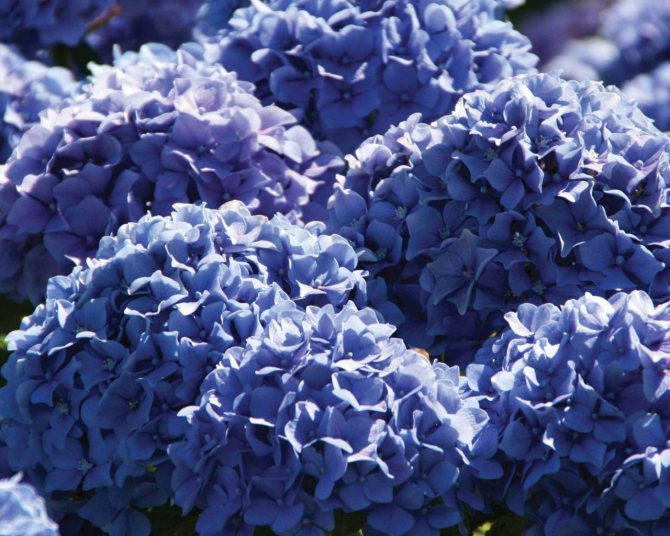

Hydrangeas come in a wide variety of colors.
Hydrangea came to Europe only at the beginning of the 14th century. Initially, the flower began to grow for the rich and noble segments of the population. It existed in two varieties: white and scarlet.
Today there are more than 70 varieties of hydrangea, it is available for planting in almost any region with fertile soil.
Hydrangea in landscape design
Hydrangea is often used to create large compositions on the site. Its beauty is emphasized by colored borders made of spirits, cotoneaster.
Due to the height, the plant is planted in the background, and a cascade of lower crops is created in front.
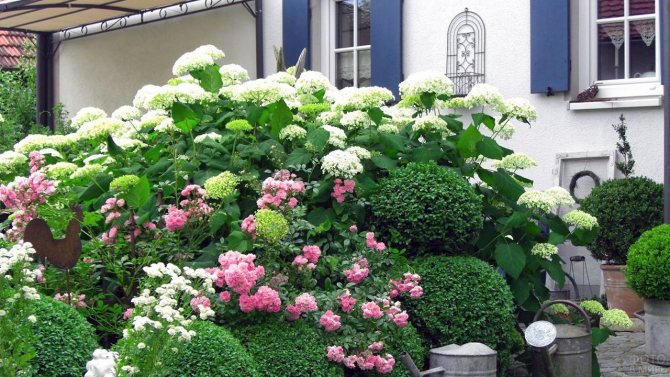

Hydrangea in a flower bed
Designers do not recommend mixing hydrangea with bright colors of warm colors: red, yellow, orange. A culture with blue inflorescences, needles or green leaves is better combined.
Also, hydrangea is widely used to create fences, decorate paths, and are used in mixborders.
Types of hydrangeas
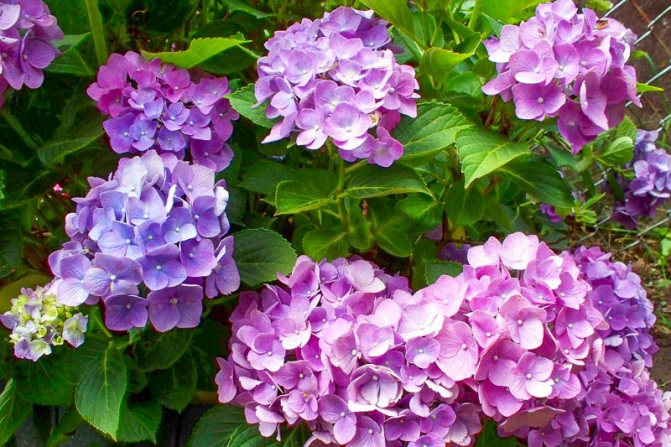

Most hydrangea (Hydrangea) - small deciduous trees or shrubs, not exceeding 1 - 3 meters in height, but there are also tree-like vines up to 30 meters high. In the Hortensiev family, there are about 80 types of hydrangeas, almost all of them are native to North America and Southeast Asia, including Japan and China. Several types of hydrangeas grow in the Russian Far East.
All hydrangeas have opposite, rounded, jagged leaves along the edges. Large corymbose inflorescences or conical panicles appear at the ends of the shoots of the current year in the second half of summer.
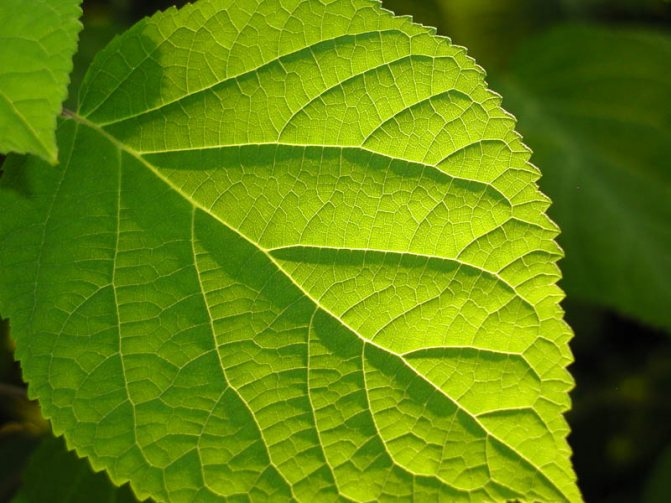

Hydrangea inflorescences consist of large, very noticeable flowers, consisting of four to five flat petals, but these flowers are sterile, and small, very unsightly flowers, but they produce seeds.
For reference: flowers from which seeds can be obtained are called fertile flowers.
In central Russia, only a few types of hydrangeas can be grown in the open field, namely: tree hydrangea, ash hydrangea, radiant hydrangea, oak hydrangea, panicle hydrangea, large-leaved hydrangea, ground cover hydrangea, Sargenta hydrangea, Hydrangea hydrangea, hydrangea.
Hydrangea tree (Hydrangea arborescens) - a very common type of hydrangea in our country, originally from North America. Hydrangea treelike is a sprawling bush of erect, up to 1 meter high shoots, shoots branch in the lower part, some lie down and take root.
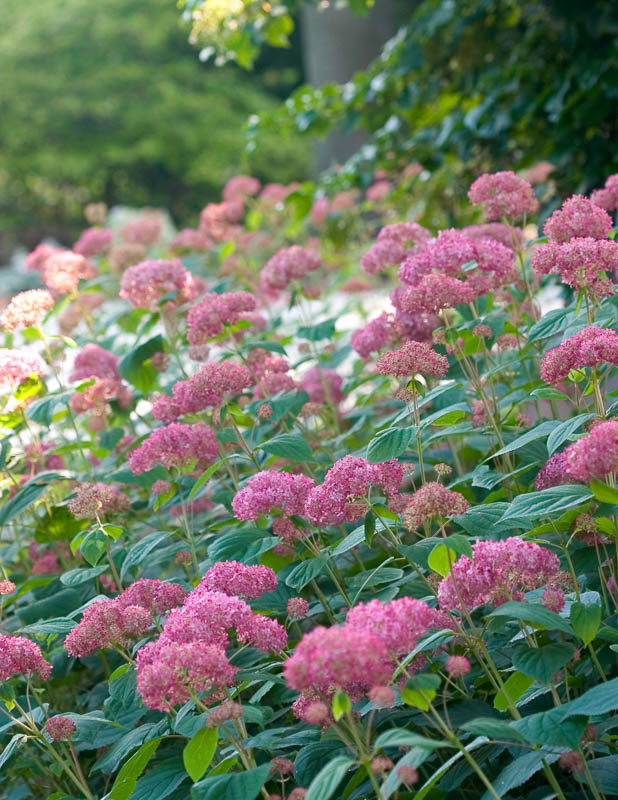

In hydrangea tree-like, light green opposite leaves up to 20 centimeters long, located on long petioles. White or pink inflorescences of tree hydrangea bloom from mid-July. The shape of the inflorescences is convex shields up to 15 - 20 centimeters in diameter, consisting of large sterile and small fertile flowers. In severe winters, immature young shoots of tree hydrangea can freeze slightly.
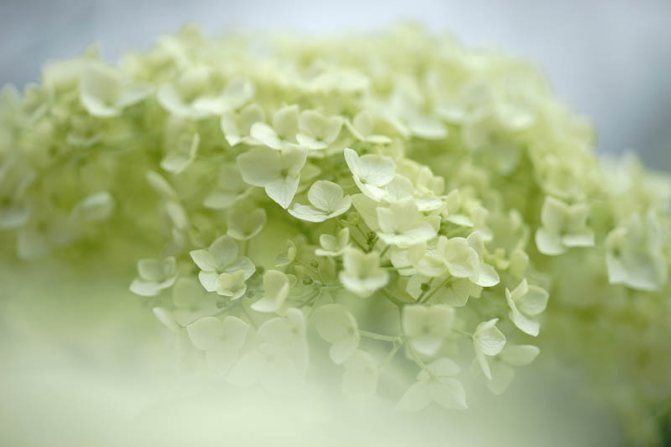

The tree hydrangea has several varieties. The most famous - Annabelle, is a short bush with dark green leaves and very large, up to 30 centimeters in diameter, round white or greenish inflorescences, consisting of sterile flowers.
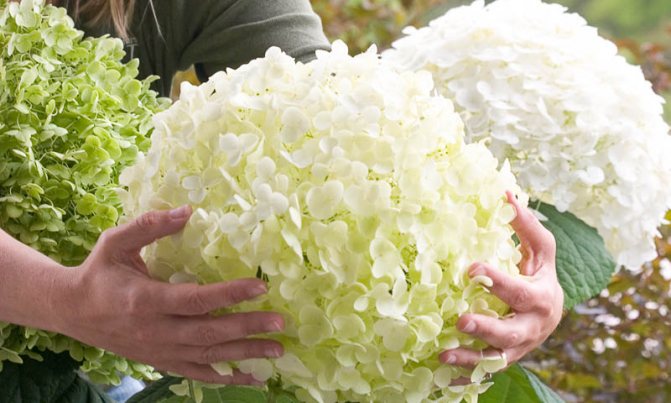

The treelike hydrangea variety Grandiflora is found more often than others, it has large, up to 20 centimeters in diameter, inflorescences of their large sterile creamy flowers, which turn green over time.
The Sterilis variety is very similar to the Grandiflora variety, only its inflorescences are slightly smaller.
For the winter, the faded inflorescences of the tree hydrangea must be cut off. Pruning weak, diseased, dry, or thickening shoots should be done either in early spring, before the leaves open, or in the summer, when all leaves are fully open.
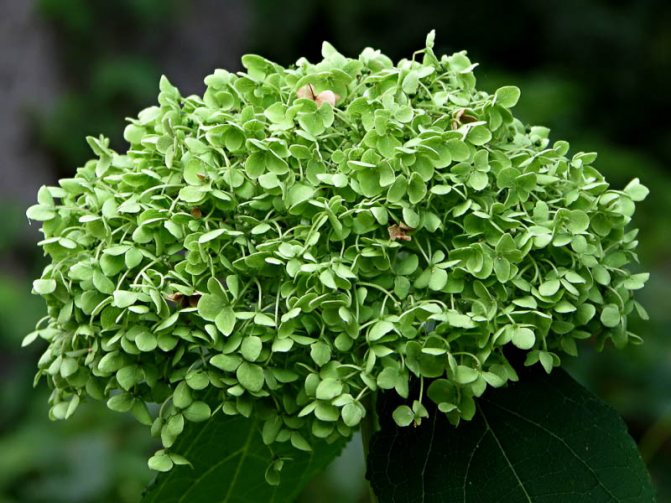

Treelike hydrangea grows well both in the sun and in partial shade. It is not very demanding to care for, unlike large-leaved hydrangea, it grows well not only on neutral, organic-rich soil, it can grow even on poor soils, although flowering suffers greatly. Treelike hydrangea is considered drought-resistant.
Treelike hydrangea can be planted in the garden in groups on lawns, next to a pond, in a border planting along the paths. It can be planted next to tree groups in a Japanese-themed garden.
Ash hydrangea (Hydrangea cinerea) - ornamental deciduous shrub up to 2 meters high with a wide spreading crown. - grayish pubescence of the underside of leaves and young shoots. Ash hydrangea leaves are broadly elliptic, serrated along the edges, up to 15 centimeters long. Inflorescences are corymbose, up to 15 centimeters in diameter. Blooms in July.
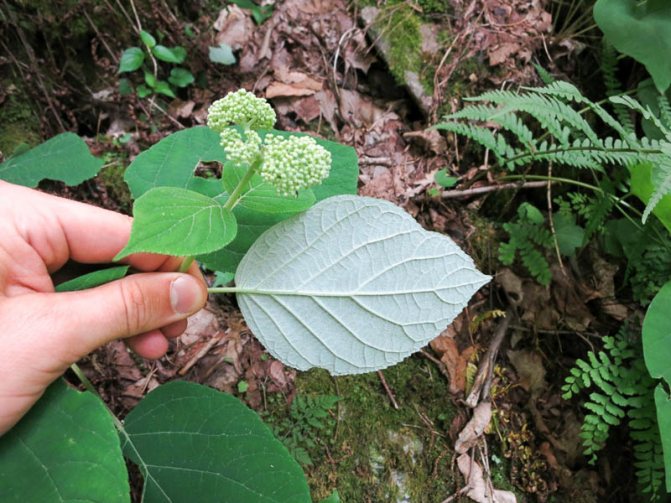

Ash hydrangea winters well in our climate, but in cold winters, young shoots can freeze slightly, although the bush quickly recovers in spring. In order not to risk, from the fall, ash hydrangea bushes can be covered for the winter.
Ashy hydrangea, just like tree hydrangea, is not very demanding on soil fertility and moisture, which makes it indispensable for planting medium-sized hedges. It tolerates partial shade well, is decorative throughout the growing season.
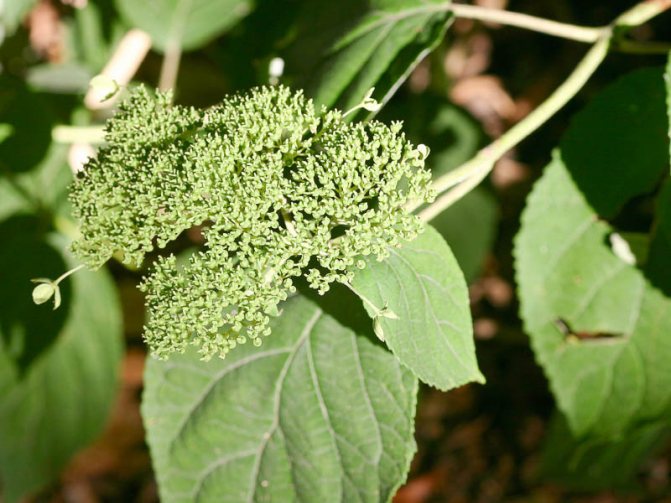

Hydrangea oakleaf (Hydrangea quercifolia) - a very decorative deciduous shrub with a height of just over 1 meter. Oak-leaved hydrangea is less known in Russia than Sargent hydrangea, but deserves attention due to its leaves, somewhat unusual for hydrangeas. They have 5-7 large blades, reach a length of 20 centimeters, in summer they are dark green, in autumn they are bronze-red or purple, very much like oak leaves. The underside of the leaves is white-tomentose.
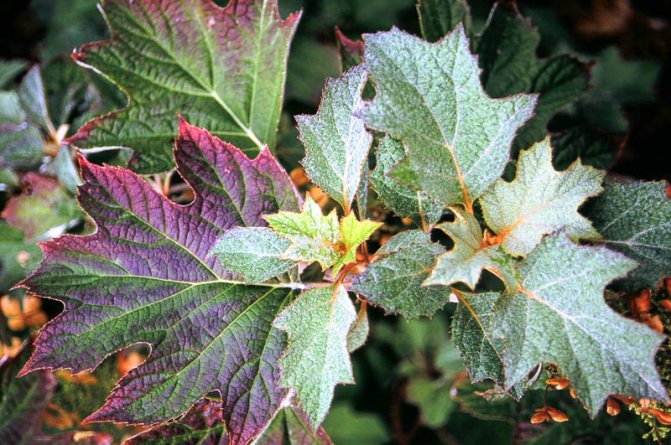

Inflorescences of hydrangea oakleaf conical, in the form of a panicle, up to 20 centimeters in length, in which there are a lot of large sterile flowers, up to 3 centimeters in diameter. At the beginning of flowering, the inflorescences are white, then turn pink, and in the fall they acquire a deeper, almost crimson color with greenery.
In cold winters, oakleaf hydrangea can freeze slightly, so it needs shelter.


Large-leaved hydrangea, or garden (Hydrangea macrophylla) Is a small, less than 1 meter tall, shrub native to Japan. The large-leaved hydrangea has bright green, toothed, up to 15 centimeters in length, leaves. Among cultivated large-leaved hydrangeas there are forms close to wild ones, with corymbose inflorescences, with separate sterile flowers. However, along with these forms, varietal hydrangeas are already widely cultivated, in which spherical, up to 25 centimeters in diameter, inflorescences consisting only of sterile flowers, usually pink in color. However, their color can change from pink to blue depending on the acidity of the soil. There are also bred resistant varieties with blue flowers.
Large-leaved hydrangea can be successfully grown in indoor culture, but it is most widespread in amateur gardens in the open field. It should be noted that despite the low winter hardiness, large-leaved hydrangea with great success, along with roses, conquers our gardens and hearts)). Large-leaved hydrangea can be used to create a garden in a poetic style.
Among the variety of modern varieties of large-leaved hydrangea, there are plants with white, red, blue flowers, the edges of the petals can be even or jagged. The most frost-resistant varieties of large-leaved hydrangea are Blue Wale, Mariesii. Care for large-leaved hydrangea.
Hydrangea paniculata (Hydrangea paniculata ) Is a deciduous shrub with a wide crown up to 1.5 - 2 meters high, which can be formed in the form of a small tree. The panicle hydrangea has very dense, oblong-rounded, dark green leaves, up to 12 centimeters in length.
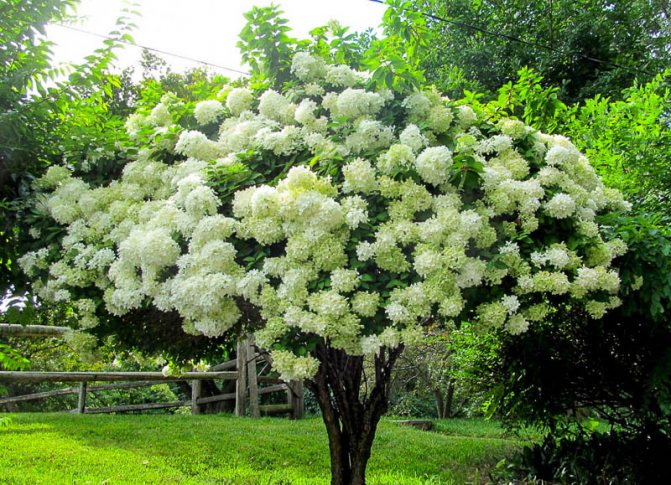

Panicle hydrangea is perhaps the most "northern" of all types of hydrangeas. It blooms from late June - mid-July to late August. Inflorescences are highly convex scutes, very similar to panicles, in which both sterile and fertile flowers are mixed. Panicle hydrangea is a very persistent and abundantly flowering hydrangea. At the very beginning of flowering, the unopened buds have a greenish color, in full dissolution the inflorescences become white, by the beginning of autumn their color smoothly turns into crimson or purple-violet.
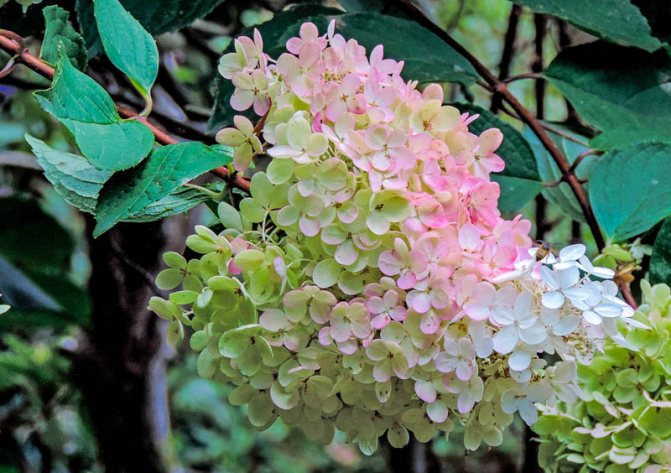

Panicle hydrangea is very winter-hardy. In late autumn, it is recommended to cut off faded inflorescences. In the spring, before bud break, the main pruning of the shoots is carried out. If the hydrangea is grown as a tree, then formative pruning should also be done in early spring.
Varieties of hydrangea paniculata: Grandiflora - with long, up to 25 centimeters conical inflorescences, in which there are many large sterile flowers; Praecox is an early flowering variety with medium-sized inflorescences, but the flowers in the inflorescence have serrated edges, Pinky-Winky, Kyushu.
Panicle hydrangea is good both as a tapeworm and in group plantings, it can grow in open areas and in light partial shade, but it is more demanding on soil moisture content than tree hydrangea.
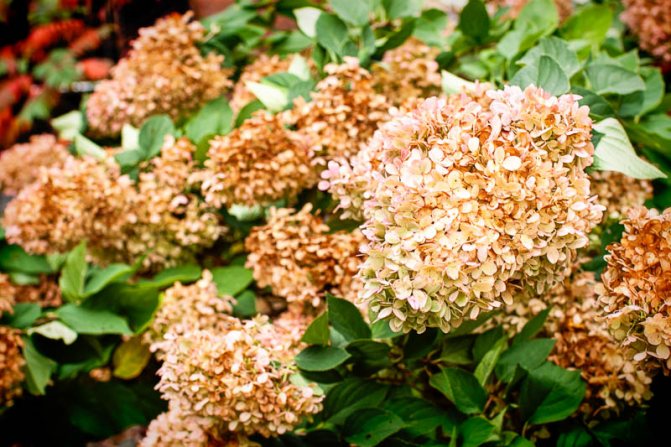

Hydrangea groundcover, or variegated (Hydrangea heteromalla) Is a deciduous, spreading shrub more than 2 meters high. Ground cover hydrangea is easy to form in the form of a tree. The upper side of the leaves is dark green, the lower one is light, covered with pubescence. Leaves up to 20 centimeters long, elliptical, with a sharp end and wedge-shaped base, are located on reddish petioles.
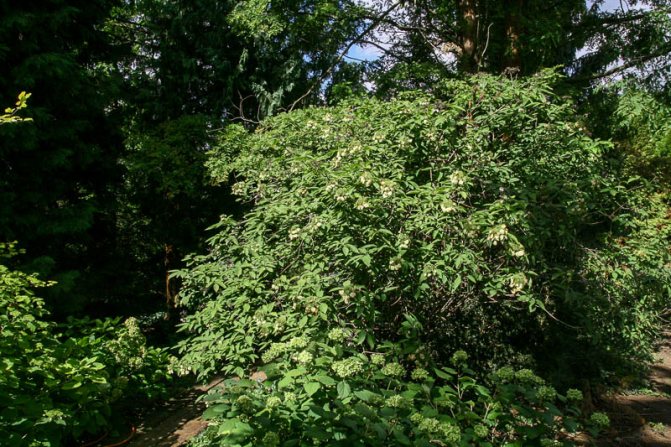

Ground cover hydrangea blooms in July. The scutellum inflorescences are wide, but liquid, contain mainly small fertile flowers, among which in some places there are sterile, larger flowers. At the beginning of flowering, the shields are white, closer to autumn they turn pink, sometimes they can acquire a brighter crimson or purple color. Hydrangea ground cover is drought-resistant, winter-hardy, grows rapidly. Easily reproduces, in spring and autumn - by dividing the bush, during the summer - by root suckers, green cuttings.
A neatly trimmed groundcover hydrangea bush is an excellent tapeworm.
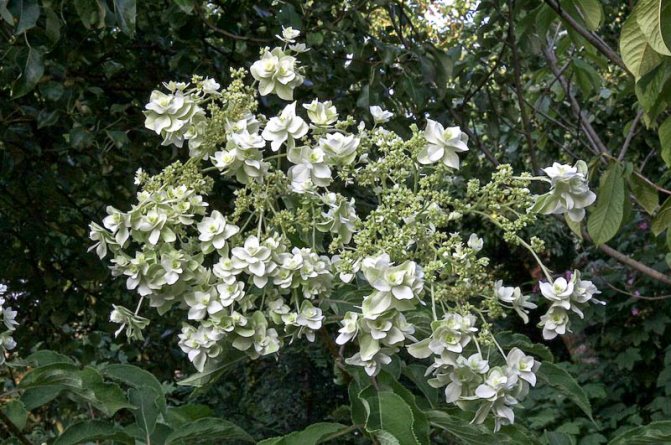

Hydrangea bretschneideri very similar to the ground cover hydrangea, differs only in smaller leaves on short petioles and not so wide inflorescences. Bretschneider's hydrangea blooms in July, the color of the inflorescences is white, by autumn it becomes crimson. Grows well in partial shade. Hydrangea is characterized by high winter hardiness, does not require shelter for the winter.
A neatly trimmed Bretschneider hydrangea bush is an excellent tapeworm.
Hydrangea sargentiana (Hydrangea sargentiana) - a very unusual Chinese hydrangea with thick, upright tomentose-pubescent shoots up to 1 meter high. She has very interesting - powerful, dark green, velvety - leaves. In July, reddish-brown inflorescences with rare white stars of sterile flowers bloom on the tops of the shoots.
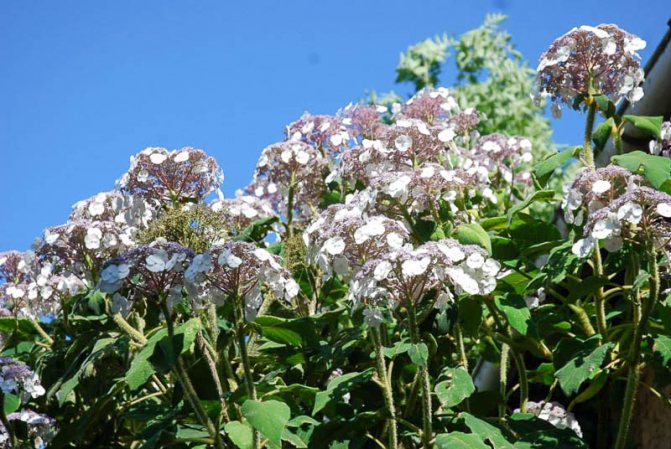

Hydrangea sargent in our climate is grown as an ordinary perennial, because every winter the shoots completely freeze at the root, but in the spring they grow back and bloom annually. Perhaps, this type of hydrangea should also be paid attention to when creating a Japanese or Chinese garden.
Hydrangea rough, or rough, (Hydrangea aspera), bristly hydrangea (Hydrangea strigosa), felt hydrangea (Hydrangea villosa) with leaves narrowed to the base and bluish flowers are the closest relatives of sargent hydrangea.Just like the sargent hydrangea, these types of hydrangeas in our climate can be grown as regular perennial herbaceous plants. They grow well in open sunny places and in partial shade.
All of these freezing types of hydrangeas will look best in mixed flower beds, including those with herbaceous perennials that mask them.
Hydrangea radiant (Hydrangea radiata) Is an upright deciduous shrub with tomentose pubescence on the shoots. Leaves are dark green, serrated, semi-heart-shaped, light below, pubescent, with reticular veins. White shields-inflorescences of radiant hydrangea bloom in July.
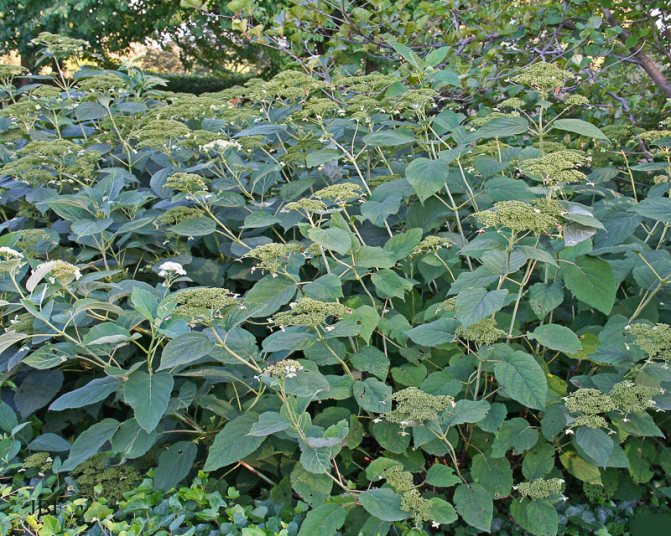

Hydrangea radiant sun-loving, but at the same time you need to monitor the moisture and fertility of the soil. The radiant hydrangea hibernates only with shelter for the winter, and it can freeze slightly, but it quickly recovers and blooms annually.
Radiant hydrangea looks good in group plantings on the lawn, it can be successfully used for border plantings along the path.
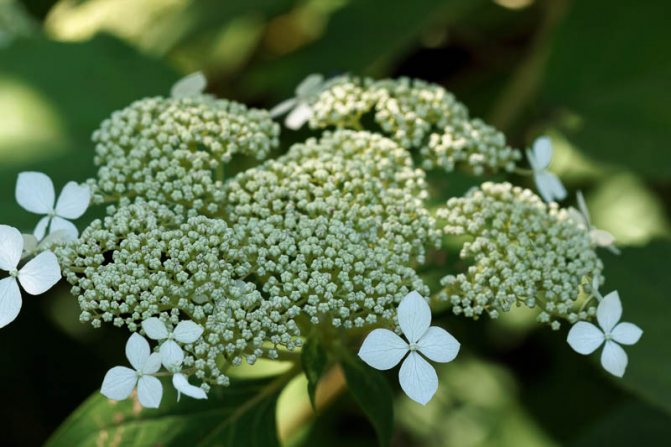

Stalked hydrangea (Hydrangea petiolaris) - liana, up to 25 meters in height, with small, green, glossy leaves and large, up to 25 centimeters, white inflorescence shields. Petiolate hydrangea can be used in vertical gardening of arbors, walls. She is quite winter hardy, prefers partial shade.
General hydrangea care
Pick-up location
Hydrangeas prefer a bright place with diffused sunlight best, so partial shade is more suitable for them in the garden - in the open sun, hydrangeas can do well only with a thick layer of mulch. For freezing species of hydrangeas, you need to choose places protected from northern winds.
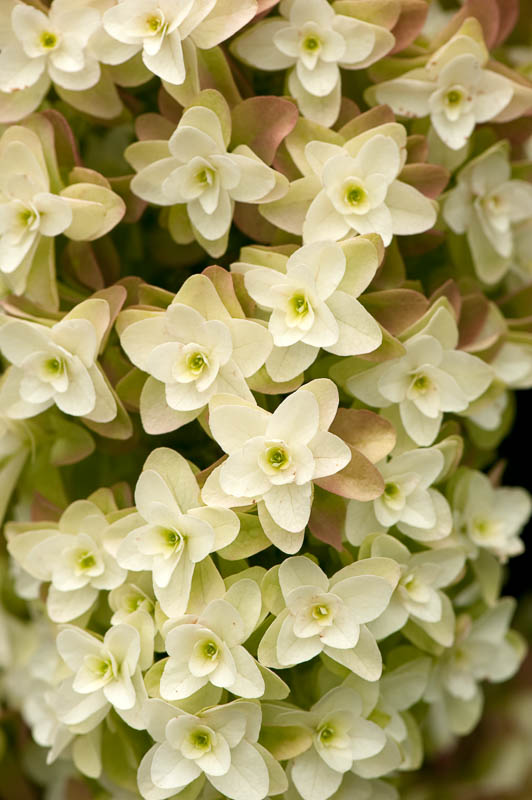

The soil
All types of hydrangeas prefer slightly or moderately acidic soils. They cannot stand the lime content of the soil at all. If a hydrangea is planted in calcareous soils, it will immediately develop leaf chlorosis.
In addition to the high requirements for acidity, the soil for hydrangeas must be fertile and moist. Large-leaved hydrangea also requires high air humidity.
During the growing season, you need to monitor the soil: it should always be loose and free of weeds. Therefore, to reduce labor costs, apply soil mulching.
Watering
Watering, if there is no rain, should be regular, up to 2 buckets per week. Rainwater is preferable, if not, then tap water needs to settle, a bag of peat can be placed in a container with water to soften, acidify. Watering is best early in the morning or in the evening, after sunset.
Top dressing
Top dressing in spring and early summer can be carried out with a weak solution of potassium permanganate, slurry. From mineral fertilizers in the spring and in the first half of summer, it is advisable to use acidic fertilizers, such as ammonium sulfate, potassium sulfate. In late summer and autumn - phosphorus-potassium fertilizers.
To change the color of large-leaved hydrangea flowers, you can use aluminum alum or iron salts.
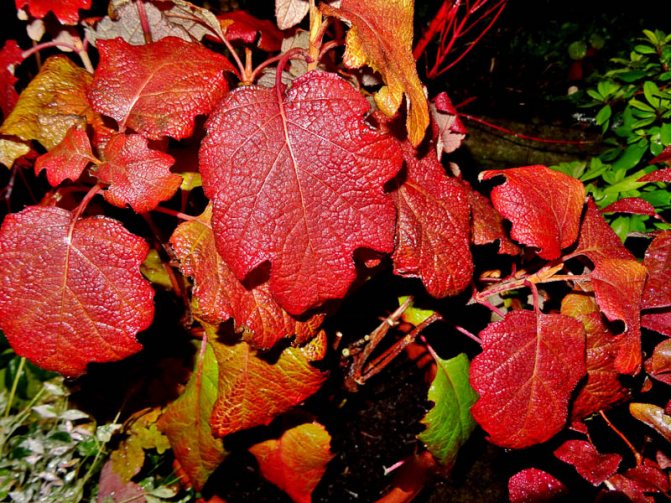

Pruning
Some types of hydrangeas need annual pruning in early spring, in the bud stage. If pruning is not carried out, then the bushes will stretch in length until they break under their own weight. Up to three - four years, hydrangea bushes do not form. As a result, adult hydrangea bushes are pruned annually.
All types of hydrangeas, except for paniculate and large-leaved, should be heavily pruned. It stimulates not only intensive growth of shoots, but also the formation of large inflorescences. Strong pruning of last year's growth is carried out annually, in early spring, only 1 - 3 internodes are left on the shoot. With light pruning, there will be many small inflorescences. But panicle hydrangea, on the contrary, blooms better with light pruning. In large-leaved hydrangea, it is very important to preserve last year's shoots completely, because it is on them that shoots with inflorescences grow next year.
Reproduction
Hydrangeas are propagated by dividing the bush better in the spring, with annual, non-lignified green shoots, cut when they are still flexible. Cuttings of hydrangea root both in water and under a jar. But it is even easier to propagate hydrangeas by layering and root suckers.
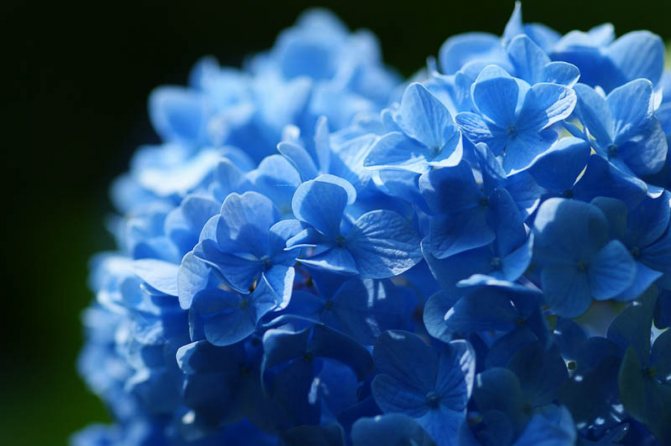

Shelter for the winter
The frost resistance of hydrangeas is different. Non-hardy, freezing types of hydrangea require shelter for the winter. The base of the bushes is sprinkled with dry sawdust, peat, humus, sand, and the top is covered with leaves or non-woven material. In addition, the large-leaved hydrangea is still covered with a box, and on top - with a polyethylene film or roofing material, so that the melt water does not get inside the shelter, otherwise the shoots from high humidity can dry out and there will be no flowering.
Rust problems
Hydrangea is often defeated. rust fungithat can infect leaves and root systems. If the root system suffers first, then after a while the leaves will also be covered with characteristic yellow spots. In this case, the rescue of the bush may be overdue.
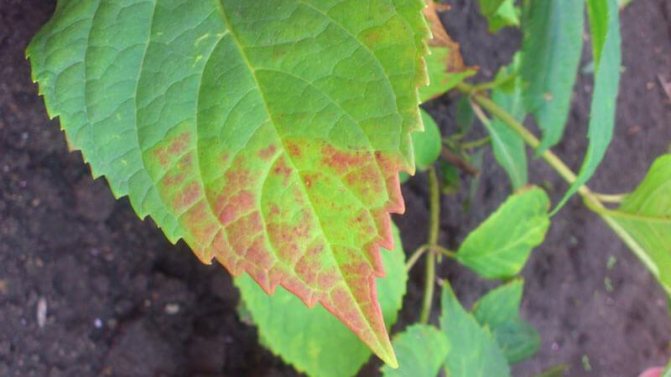

You should also be extremely careful with other plants, as they can also be affected by fungal diseases.
The reasons for the presented problem may be an excess of nitrogen fertilizers or wet weather for a long time. Fight rust on garden hydrangea flowers happens as follows:
- even at the initial stage, it is necessary to monitor compliance with the rules for planting seedlings - no more than 5 bushes per 10x1 m plot;
- it is very important to remove weeds in a timely manner, which can also become carriers of the described rust;
- for dressing, you should use only phosphorus-potassium fertilizers and do not abuse nitrogen compounds;
- watering must also be done carefully, without moisture getting on the leaves;
- use only settled water for irrigation;
- leaves fallen in the fall can cause rust formation, so they should be removed while preparing the shrub for winter.
The presented actions will be able not only to protect the hydrangea from the formation of rot on the leaves, but also to rid other already affected plants. Also, to remove rust, you can use special compounds that are purchased in specialized stores.
They are used for spraying affected bushes and watering the root system. If only some of the shoots are rusty, it is best to prune them to prevent the problem from spreading throughout the area.
Transfer
- It is best to transplant hydrangeas in early spring, right after the snow melts. In the southern regions, this can be done in the fall.
- A plant with a large clod of earth is transplanted, trying to preserve it as much as possible and not damage the roots. After transplanting, the shrub is watered.
- Before or after the transplant, the hydrangea is pruned, it is more convenient to do this first. In this case, the shoots are shortened by a third of the length according to the rules of formative pruning.
- If, when digging up a bush, the root system is damaged or the earthen lump has collapsed, pruning is carried out more radically, otherwise the plant may not take root.
- In the next 2-3 weeks, the transplanted hydrangea needs to be shaded a little from the bright sun.
- It is important to remember to water regularly in hot, dry weather.
- Top dressing of the plant can be performed no earlier than 3-4 weeks after transplanting, when the growth of shoots resumes, which is a sign that rooting has taken place successfully.
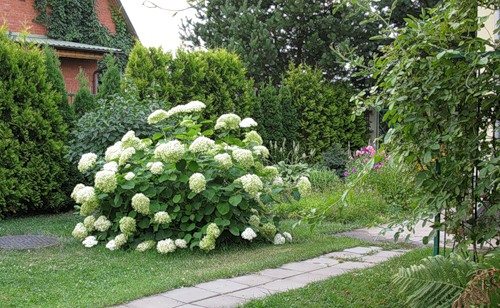

Care instructions during plant growth and development
Proper care of plants during growth is the key to healthy and beautiful shrubs in the future. After all, it is important to help our small bush grow into a voluminous and fluffy flower, which will be a decoration of the summer cottage for many years.
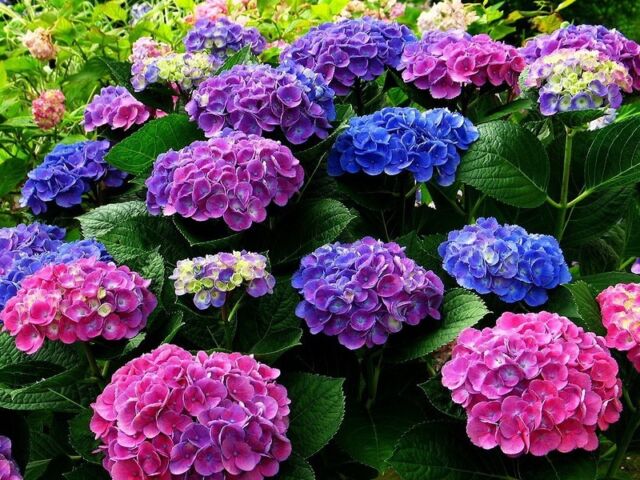

Small plants need special care as they grow.For the first time, after planting them in open ground, it is better to cover them with a special plastic wrap, as it is also called - spunbond. It is a very thin, special film that is capable of reflecting ultraviolet rays. Its appearance is similar to tissue fiber.
This film can be purchased at garden stores or markets. The shelter is made so that our seedlings do not burn out under the rays of the sun.
It is worth remembering that this green culture is afraid of winds and drafts. It is recommended to fasten a small stake near the bush and lightly tie it to it with a rope. This will serve as a support and will not allow the young shoot to break during the wind.
For more active growth, fertilization is periodically necessary.
If the shoots are thin, the leaves began to brighten and acquire a yellow tint, then this is a signal that the plant does not have enough nutrients for active growth.
As a rule, it is imperative to feed the plants in the spring. During the spring period, it is necessary to fertilize 2-3 times, and the emphasis is on the nitrogen content. Also add organic fertilizers such as manure, compost.
If, during planting, you added minerals to the hole, then for 1-2 years you can not apply fertilizers. Monitor his condition as he grows.
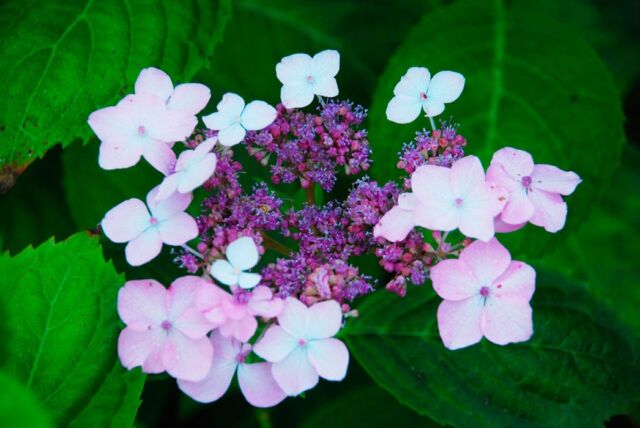

This moisture-loving plant needs timely watering. During growth, it will be enough to pour in 1 bucket for each bush, once a week. This must be done carefully under the roots so as not to damage the young branches.
For better growth, cut off the buds that appear so that all the power is directed specifically to the branches of the bush, and not to the inflorescences.
During the growing period, you can also water the bushes with the addition of dyes, so that the inflorescences are multi-colored. This applies to varieties of hydrangea that change color.
Adult plant care
Proper care of the plant will give you the opportunity to admire beautiful flowers for a long time. What should be done to make the bushes comfortable to grow?
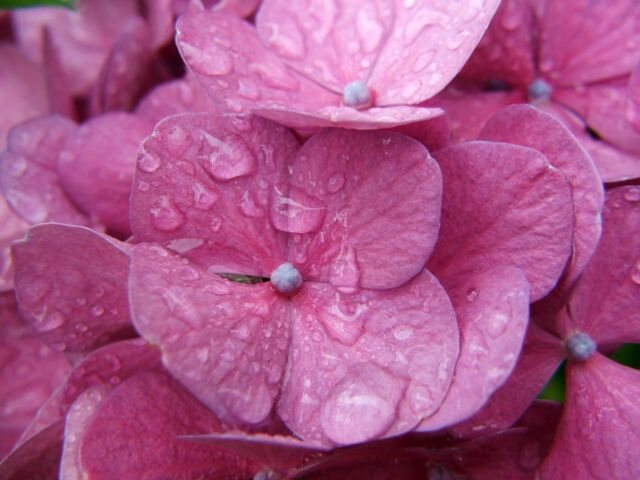

Mature bushes need constant watering. The soil should not dry out. You need to water every week, pour 2 buckets of water under the root. Moreover, the water should be free of lime. After all, lime is destructive to the roots of the plant. Rainwater works very well. To do this, place the barrel in the area where water will be collected for further watering.
As soon as the snow melts, you need to feed the soil, which is depleted after the winter period. For fertilization, you can use both purchased solutions of mineral fertilizers and folk remedies. In the first feeding, use nitrogen fertilizers; a urea solution is well suited.
Prepare a solution at the rate of 1 tablespoon of urea per 10 liters of water. For one bush, 5 liters of ready-made fertilizers will be enough.
The next top dressing is performed at the time of the formation of the buds of the inflorescences. And in the future, it will be enough once a month during the summer season. Monitor the condition of the bush, the branches should be strong, and the leaves should be bright green. This will say that the plant has enough nutrients in the soil.
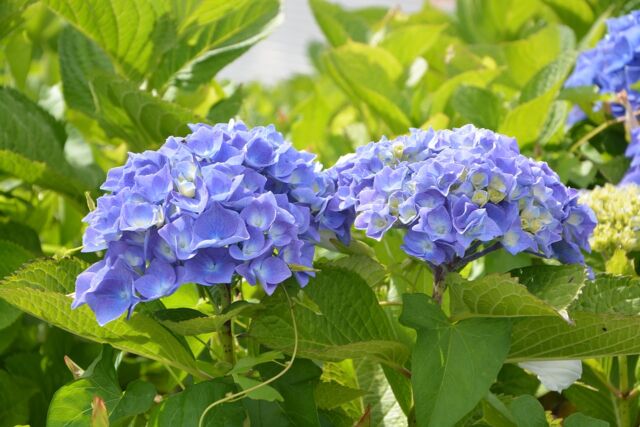

To shape the bush, it must be cut off. This should be done in the spring. Broken branches frozen after frost are removed. You can also cut off growing crooked young shoots. The first pruning is done 2 to 3 years later, after planting the plant.
These flowers are resistant to diseases and pests. Therefore, they do not need to treat the leaves from pests.
Compositions with hydrangea
All hydrangeas are planted in those places in the garden where you need to add volume and revive the composition. Hydrangeas bloom from July to October.
| TIP If you do not cut the hydrangea in the fall, then dry inflorescences will add volume and beauty in the winter garden. |
Place for hydrangea
Hydrangea is planted along fences, paths, in flower beds, in corners, like a tapeworm on a lawn.
It is best to plant hydrangeas near buildings and in places protected from the wind. This will help her get through the winter successfully.
The hydrangea bushes are sheltered from the winds and feel great. Next to the hydrangea, there is a border of spirea, and in the background, a vertical gardening of the wall of maiden grapes. _______________________________________________
Read about growing, the nuances of planting, pruning and caring for hydrangeas here
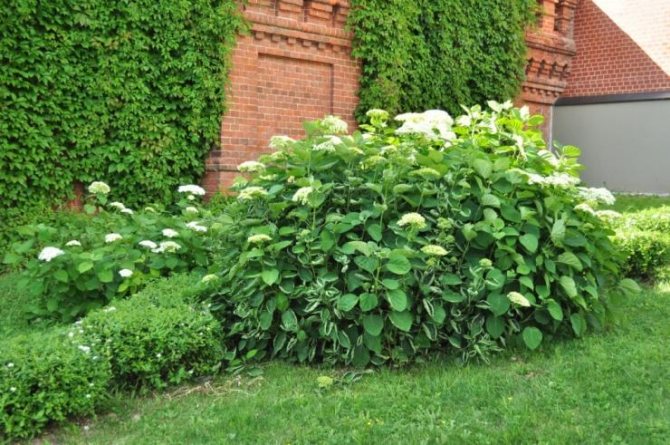

Photo: hydrangea with spireas near the wall of the house
Hydrangeas with perennials and flowers
Hydrangeas are beautifully combined with ornamental shrubs and flowers:
- chubushnik,
- clematis,
- roses,
- lily,
- peonies,
- rhododendron,
- weigeloy,
- barberry,
- lilac,
- spireas,
- conifers.
Hydrangea coexists with phlox, lilac and hosts.
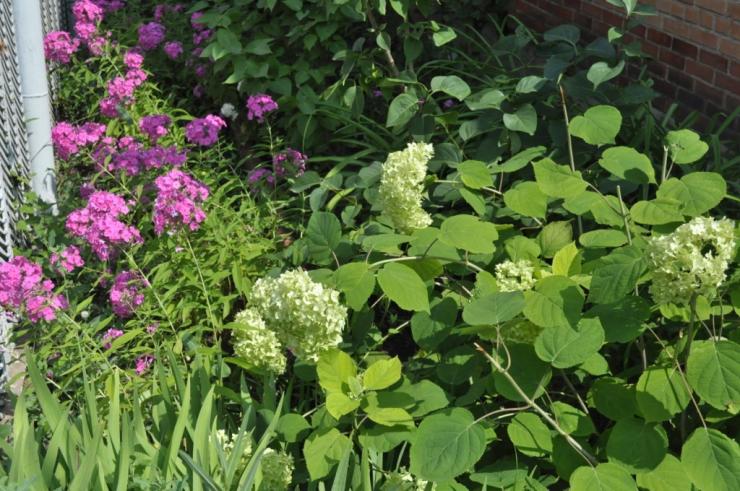

Photo: hydrangea with phlox and lilac
When planting hydrangeas near a pond, surrounded by it, you can plant:
- various hosts,
- badans,
- sow thistle,
- irises,
- astilbe.
Thus, in the period when it is the least decorative, beautiful moisture-loving plants will attract attention.
The panicle hydrangea is formed in the form of a tree with one trunk. An openwork cosmeya surrounds it, and a badan is located below.
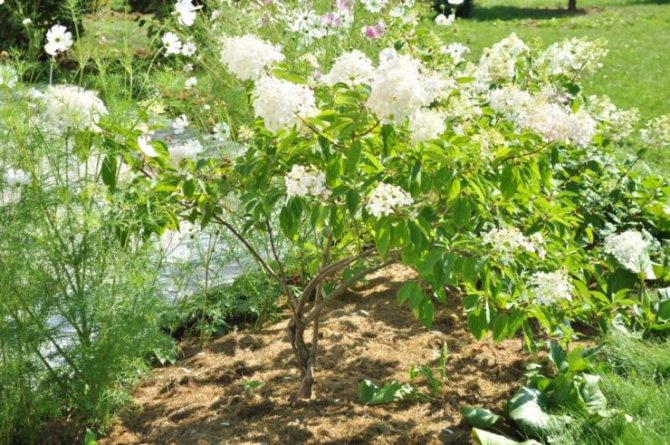

Photo: hydrangea with cosmos and badan
Alley with hydrangeas
The hydrangea looks very beautiful planted in the alley. For example, the hydrangea is still small, but when it grows up, it will be an enchanting sight. The bushes will become sprawling, and huge caps of flowers will be scattered from top to bottom.
When planting hydrangeas in the alley, observe the distance between the bushes of 1.5 - 2 meters, so you will lay the necessary distance for their full further development.
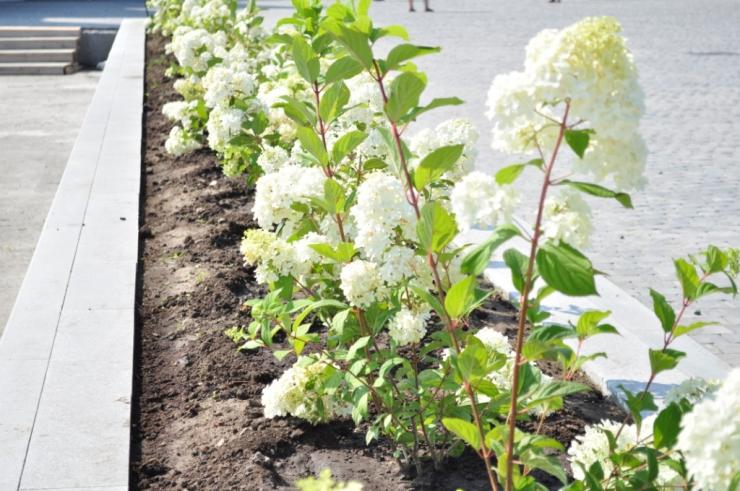

Photo: alley of hydrangeas
Hydrangea in a mixborder
A hydrangea bush in a flower garden, barberry, thuja and peonies are planted nearby.
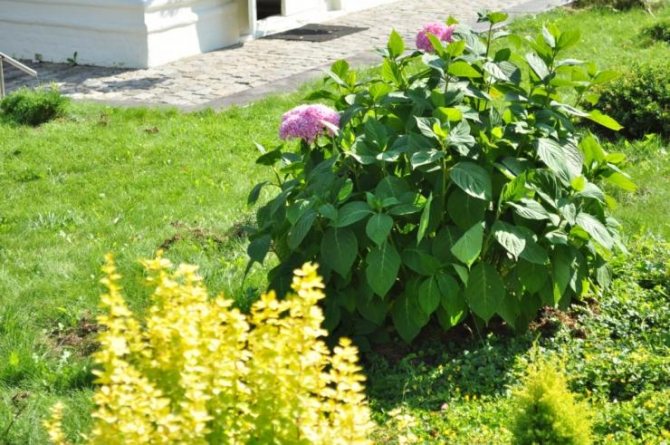

Photo: hydrangea in a flower garden
Treelike hydrangea bush in a flower garden. Bright annual tagetis and cineraria are planted along the path. Various perennials grow in the background. With this technique, you can change the flower garden every season, planting various annuals without changing the background.
Photo: hydrangea with perennial and annual plants
Solitaire planting of hydrangeas
The hydrangea looks very beautiful as a tapeworm on a lawn or open area.
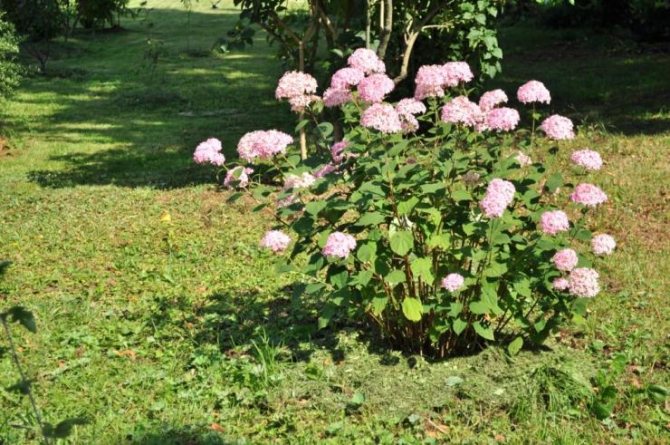

Photo: tree hydrangea Invisible Spirit
Here again a hydrangea as a tapeworm on a green lawn, near a flower garden.
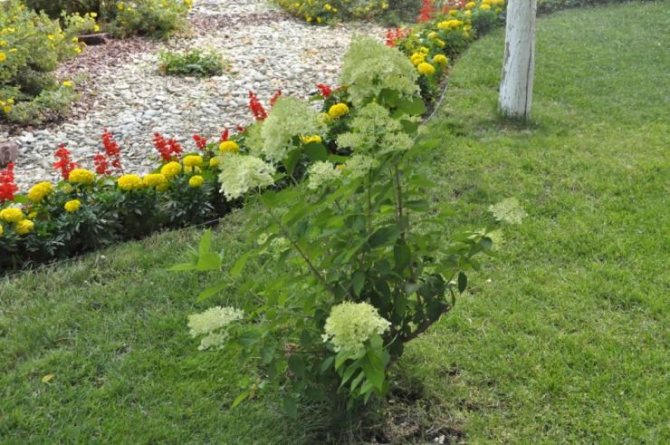

Photo: hydrangea on the lawn
Are hydrangeas threatened by pests?
The hydrangea is ready to give luxurious flowers to its owners every season. Surprisingly, this beautiful plant is uniquely rarely "sick".
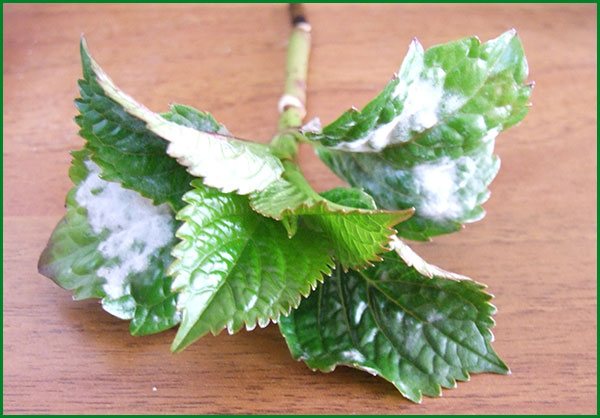

Powdery mildew on hydrangea leaves
There are only a few variants of diseases that can affect it, which is easy enough to fight:
- yellow spots of a mosaic shape on the leaves indicate a mosaic disease, which can be removed by simply cutting down all affected shoots;
- spraying with Bordeaux liquid will rid shrubs or trees of insect pests;
- fungal disease "gray rot" or "powdery mildew" can affect the entire surface of the branches and leaves, such a plant will have to be cut down to the root and spray the soil with special protective compounds, such as Furdozon.
For what reasons may a hydrangea refuse to bloom?
The simplest answer to this question is a careful assessment of the correctness of the chosen landing site. If it is located in a too dark area, or vice versa, the area is constantly watered with direct sunlight, the plant simply feels uncomfortable. But why does hydrangea not bloom with careful and proper care?
Experienced gardeners identify five leading reasons:
- Lack of watering, it is not for nothing that the Latin name of the Hydrangea family is translated “a vessel with water”.
- Root system of a weakened type, including in the first years after planting on open ground.
- Incorrect pruning of the upper shoots with the removal of flower buds, 3-5 for shrub species and the upper on a branch for tree-like ones.
- Damage to flowering buds in severe frosts.
- The choice of a variety that is unsuitable for growth in a given area, often too thermophilic.
Most of these reasons can be easily eliminated with the help of improved plant care and the question of why hydrangea does not bloom anymore in front of the gardener will not get up.
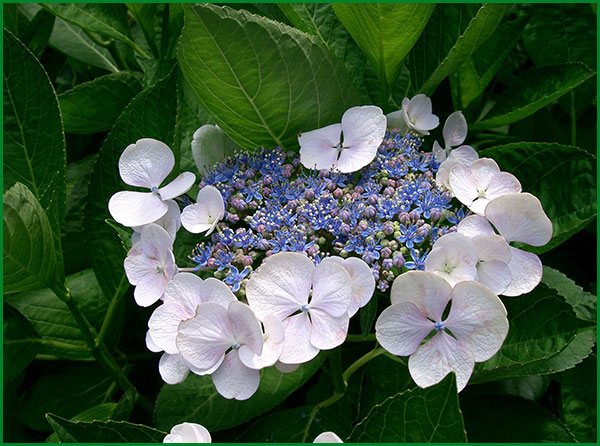

Serrate hydrangea
Hydrangea is comfortable and easy to care for. Even minimal horticultural skills will allow you to grow a luxurious plant with a lush head of flowers. It only needs to be watered in a timely manner and prepared for the beginning of a new season or winter. Those who have not grown hydrangeas before should start with simple and most undemanding species, such as, for example, panicle hydrangea or Bretschneider hydrangea with the highest level of frost resistance. In return, this amazing flower is ready to become a long-lasting luxury decoration for any garden.
Photos of plants
Here you can see a photo of blooming hydrangeas.
Features of planting in the regions of Russia (in the Urals, Siberia, Moscow region)
Despite the fact that hydrangea is a rather unpretentious plant, certain nuances must be taken into account when planting in different zones of Russia.
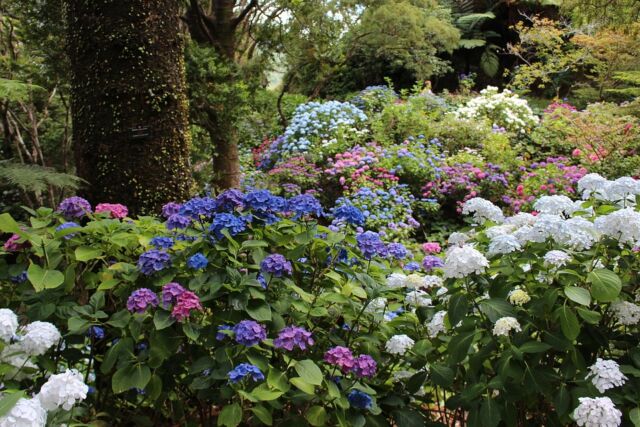

In the Urals, she feels very comfortable. This region is distinguished by medium - warm summers and cold, frosty winters. Due to the geographic location, rainfall is very uneven. Therefore, when planting a plant, it is worth paying special attention to the choice of the place where the flower will grow.
The place should be where the sun shines until noon. Better near the fence or wall of the house, so that drafts do not cause harm. Avoid places where water stagnates, as too much water is also harmful.
Suitable varieties for the Urals will be:
- Unique... Large, paniculate variety. Inflorescences are snow-white, gradually starting to turn pink. Temperature resistance to frost up to - 35 degrees;
- Sterilis... Arboreal, blooms for a long time, up to October. Flowers of a beautiful greenish-white shade;
- Hot chocolates... Differs in its leaves, they are brownish in color. Inflorescences are pink, with a purple admixture.
In the Moscow region, the summer is moderately warm, and the winter is not characterized by severe frosts. In this temperate climate, the bushes tolerate winter well, some varieties do not even need to be covered with a film. The best time to plant in this region is early May or early September. During this period, the soil is warmed up, the snow has melted and the plant may not be afraid of frost.
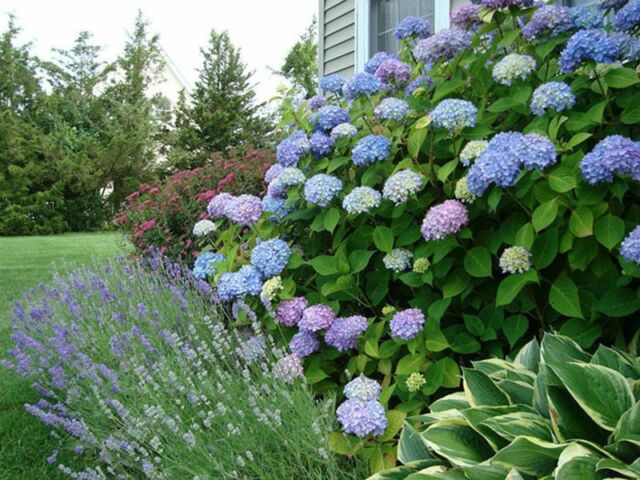

The best varieties for the Moscow region are:
- Grandiflora... Paniculate variety, in which the color of the inflorescence changes during the flowering process from white to green-pink;
- Kyushu... Panicled, loves clay-rich soil. The bush is fluffy and dense, the inflorescences change color from the acid content in the ground;
- Breitschneiber... The variety is large-leaved, with powerful, tall bush branches. Inflorescences are beige, large diameter.
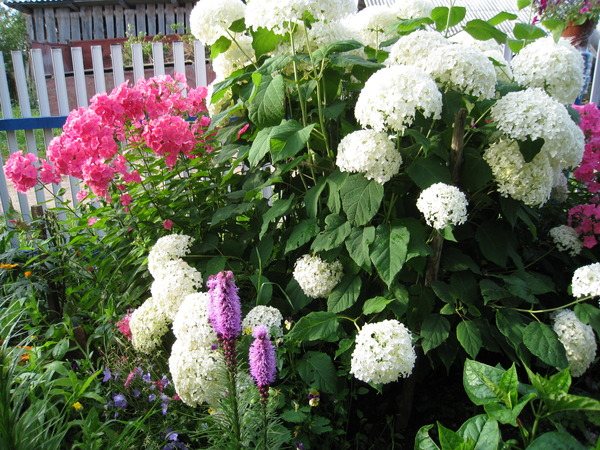

Siberia in Russia is one of the coldest regions. After all, the Siberian winter is very harsh and frosts can reach up to -60 degrees. Therefore, it is not so easy to grow a hydrangea in these conditions. The summer season is short and night frosts come quickly in autumn.
You need to plant it only with the help of seedlings, because this is a more effective way of growing than seed. As soon as the snow melts and the soil warms up, immediately plant young bushes in open ground, apply fertilizer every month. This will allow the plant to grow stronger for the winter. Choose the most frost-resistant varieties and cover these green crops carefully so that frosts cannot reach them.
Pay attention to these varieties:
- Pinky Winky... Interesting, frost-resistant variety. It has inflorescences of 2 colors, white and pink.
- Lime Light... Tall shrubs, up to 3 meters long. Inflorescences change color during blooming from light green to white;
- Phantom... It has spreading caps of snow-white inflorescences with a purple tint; it begins to bloom late from August to autumn frosts.
Choosing a place to place an ornamental plant
All types and varieties of hydrangea appreciate sun and light. For this reason, it is better to allocate a place for holes in illuminated areas of the summer cottage, but not in the open sun.
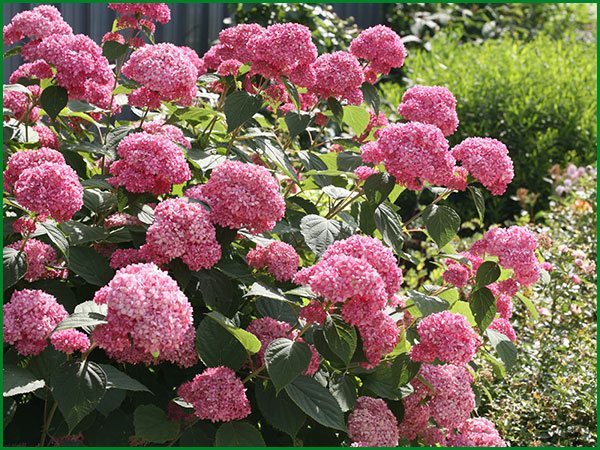

Hydrangea suitable for sunny areas and partial shade
A bush, tree or vine grows beautifully. It is also advisable to take this into account in advance. The root system is also very horizontally branched. Often it exceeds the plant crown in terms of its area.
Sixth step: periodically loosen the soil
Now let's move on to how to care for a hydrangea in the country during its active period. During the season, you need to loosen the soil around the plant twice with a depth of about six centimeters. This is best done after weeding and watering. Typically, long-toothed hoes are used to provide airflow to the roots.
To retain moisture, flower growers practice mulching the trunk circle. It is recommended to use old sawdust, pine needles, peat and moss. They will save moisture and get rid of weeds. Each layer should be about five centimeters thick. For example, if mulch is covered in spring, it will perfectly retain its properties until autumn. Experienced growers prefer this particular method of soil care. Because it is guaranteed to free you from constant loosening and weeding. It will only be necessary to water and feed.
Reproduction by root suckers
You can grow a hydrangea from seeds by dividing the bush and by cuttings. The plant reproduces very well by root suckers. Offspring, or shoots, is a young shoot extending from the root, which, during growth, forms its own root system.
Important! Depending on the bush, many offspring may form on the plant, or, conversely, none, so you need to carefully monitor the hydrangea and, in the presence of powerful offspring, carry out the planting procedure.
The offspring, along with the resulting roots, are carefully dug out without harming the mother bush. They are transplanted to another place and take care of it as a full-fledged plant.
The composition of the bookmark when landing
As noted above, for the accelerated growth of a plant, it must be fertilized at the time of planting. To do this, before immersing the cutting into the hole, it is necessary to put useful components, among which there must be a mass of substances intended to strengthen the plant, as well as fertilizers.
What does a garden hydrangea require for its strengthening and early rooting? The composition of the mixture that has a direct effect on these processes should include soil with humus, as well as sand and peat, taken in proportions of 2: 2: 1: 1.
Speaking about fertilizers, it should be noted that hydrangea is a rather picky plant towards them. As noted by most specialists in the field of landscape design, in order for the shrub to absorb the largest amount of useful components, due to which it grows quickly and blooms profusely, superphosphates in the form of granules (60 g), humus (10 kg), potassium sulfide, as well as urea (20 g).
When planting a plant, you must pay attention to the fact that the garden hydrangea is disgustingly tolerated by staying in calcareous soil. That is why it is necessary to completely exclude the ingress of lime into the ground.
Combination with other plants
The peculiarity of the garden hydrangea is that it goes well both with its relatives and with other deciduous, flowering and even coniferous plants. These luxurious shrubs look especially harmonious with sheared barberries, daylilies, as well as low-growing junipers. When planning a landscape design in which paniculate hydrangea will be present, you should pay attention to the viburnum bladder, as well as purple-leaved barberries.
This luxurious plant should be planted in the background. So it will not shade other plants, and will also act as a bright and very beautiful background. Varieties that grow as small shrubs can be planted along garden paths and as hedges.
Why doesn't it bloom in the garden and what should be done in such cases?
This is perhaps the most important disappointment of the grower. Well, in the first year - of course, it's too early for her. And then? The reason may be:
- an incorrectly selected variety for a given region;
- artificial stimulation of the pre-sale specimen, which can be seen from the outlined buds;
- a sharp change in the substrate in which the purchased plant was located, and the garden soil;
- lack of root development;
- early release of the bush in the spring from the frost-protective cover;
- frost damage to the upper bud buds;
- improper pruning of stems, with the removal of flower buds;
- the constant stay of the plant in the shade;
- lack of a complex of dressings.
Correct identification of the reasons will help to correctly eliminate them, and wait for the solemn moment: the lush flowering of the hydrangea bush.
General characteristics of hydrangea for Russian gardens
The genus of the plant belongs to a large group of the hydrangea family. It includes small trees and bushes. There are more than 80 species of plants in the group. Hortense came to Russia from Japan. The plant emits such a distinct aroma that even a single small flower will create a pleasant summer incense. For a long time, flowers have adorned apartments, but breeders have created species that have adorned the plots. Hortense is no longer afraid of the cold climate, frost and rain. Thanks to the labors of scientists, lush buds became popular throughout the country.

